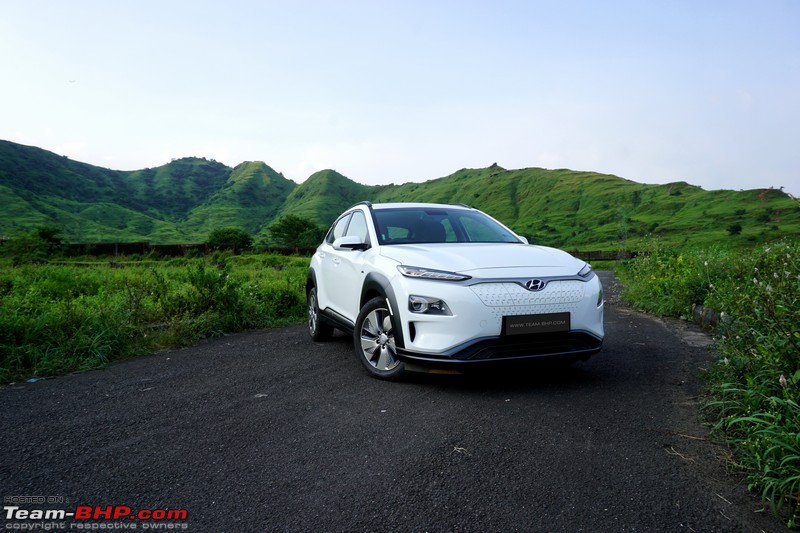| | #1 |
| Senior - BHPian Join Date: Apr 2018 Location: Bangalore
Posts: 1,546
Thanked: 17,346 Times
| Hyundai Kona : Official Review The Hyundai Kona Electric is on sale in India at a price of Rs. 23.72 lakhs (ex-Delhi). What you'll like: • India’s first world-class EV with no major compromises! • Green image & zero tailpipe emissions appeal to the environmentally conscious • Instant torque makes it a snappy car to drive in the city (0-100 km/h @ 9.7 sec) • Selectable levels of regenerative braking; adds range, aids braking performance and is fun • Real-world range of 260-300 km means no range anxiety for urban commuting • Incredibly low running costs & cheaper long-term maintenance (as is the case with all EVs) • Features such as cooled front seats, LED headlamps, sunroof, cruise control & more • Top safety kit includes 6 airbags, ESP, HSA, TPMS etc. • Peace of mind with Hyundai’s after-sales service & 8-year battery warranty What you won't: • Expensive! Even after subsidies, EVs still carry a huge price premium over ICE cars • Lack of charging infrastructure & ~300 km range limits long-distance / highway usability • Uncomfortable ride quality on less than perfect roads. Firm & uncompromising • Cabin space is comparable to the i20. Also, high floorpan affects the rear seating position • Some misses such as no auto-wipers, rear air-con, touchscreen ICE smaller than expected... • Size & presence are comparable to 12-lakh rupee cars like the S-Cross • Boot size is just 332 liters • Brake pedal lacks feel & linearity, takes some getting used to. Especially wooden in Sports mode • Limited availability in India (only a handful of states). Further, the 2019 batch is sold out Last edited by Aditya : 15th October 2019 at 10:03. |
| |  (68)
Thanks (68)
Thanks
 |
| The following 68 BHPians Thank ChiragM for this useful post: | 2himanshu, Aafaq, ADI7YAK, aeroamit, akshay81, arbaz906, BigBrad, carrazy, Chrome6Boy, CrAzY dRiVeR, dailydriver, Dani7766, darklord, dg2332, DrANTO, Enobarbus, espraveen, frankmehta, Gannu_1, gauravanekar, GTO, GutsyGibbon, haisaikat, hemanth.anand, hmansari, InControl, Ithaca, jailbird_fynix, kauphylover, Keynote, Klub Class, lemedico, Leoshashi, Malyaj, Miyata, Moto$apien, MSAneesh, mvadg, N33raj, Obi-Wan, Omkar, PapaKiloSierra9, phoenixash, RaghuVis, RavenAvi, Rehaan, Reinhard, Ronak_7, sachinshastry, samabhi, samaspire, shipnil, Simat, SpideyBoy, sri_tesla, SS-Traveller, sunsivj, swiftnfurious, Tgo, theexperthand, THE_DRIFTER, The_Outsider!, vaasu, vb-saan, Vik0728, VTec_KickedInYo, warrioraks, wheelguy |
| |
| | #2 |
| Senior - BHPian Join Date: Apr 2018 Location: Bangalore
Posts: 1,546
Thanked: 17,346 Times
| Review Index: Exterior Last edited by Aditya : 15th October 2019 at 10:25. |
| |  (18)
Thanks (18)
Thanks
 |
| The following 18 BHPians Thank ChiragM for this useful post: | autonarr, dailydriver, Enobarbus, Gannu_1, GTO, Guna, Ithaca, Klub Class, Leoshashi, Moto$apien, MSAneesh, Omkar, phoenixash, RavenAvi, Rehaan, Simat, theexperthand, vb-saan |
| | #3 |
| Senior - BHPian Join Date: Apr 2018 Location: Bangalore
Posts: 1,546
Thanked: 17,346 Times
| Exterior 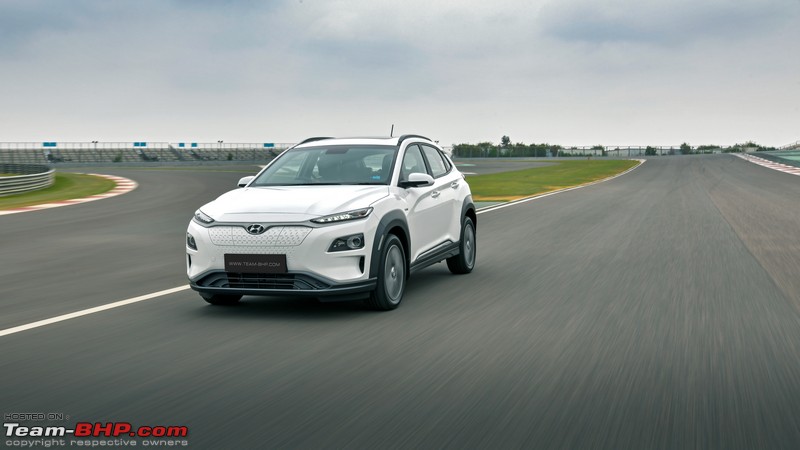 Since the launch of the Reva electric car in 2001, only a sparse handful of electric vehicles have made an appearance in the Indian market. However, none of them have garnered as much attention as the Hyundai Kona. Unlike all the electric cars offered in India until now, the Kona is a well-rounded and internationally established product, provides an extremely high driving range, is available to private owners and isn’t ridiculously overpriced. Hyundai says that they are trying to capitalize by “combining two of the fastest growing trends in the auto market - SUVs + electrification”. Mind you, we’d consider this a crossover rather than an SUV, but that seems to just be the nomenclature these days. Any manufacturer making inroads into the electric car market at such a nascent stage also has to do the hard work of setting up the infrastructure, as well as battling the stigmas and concerns associated with electric cars (related thread: Electric Cars...through the eyes of a diehard petrol-head). It’s not an easy or financially rewarding first move, but respect to Hyundai for being a pioneer here. Since Maruti hasn’t done it yet, there’s no one better than India’s #2 manufacturer to kick things off. Being an electric car, the Kona is more expensive than equivalent fuel-powered cars. This leaves us with two ways to look at the situation. Either we compare the Kona with other cars in the same price bracket, or we compare the Kona to equivalent sized & spec’d cars, and simply write-off the price difference as an “EV premium”. For example, cars like the A-Class, Beetle, Fiat 500 and the Mini Cooper are priced much higher compared to what they offer size & feature wise. But they sell anyway due to fulfilling a particular niche need (looks, design, status). The Kona will do the same, fulfilling the need of being sustainable & environmentally friendly. There are a lot of buyers who are eager to buy an electric car and don’t mind paying a premium, but just haven’t had an option to pick so far. There hasn't been much to choose from apart from the ridiculously priced Prius, toy-car e2o, much higher-priced Camry Hybrid, etc. Hyundai says they hope to fill this niche, and predict sales of 500 units per annum for the Kona in India. In the international market, Hyundai offers the Kona in two battery capacities - 39 kWh and 64 kWh. In India, Hyundai decided to offer only the 39 kWh version to keep the costs down. In the UK, the price difference between the two variants is around GBP 4,125. This would have made the 64 kWh version of the Kona Electric cost roughly Rs. 4 lakh more than the current car. The 64 kWh offers a lot more range as well as a higher power output. Would Kona customers be willing to pay that extra amount for an additional ~190 km of range, especially given the extreme scarcity of EV charging points in India? Perhaps a warm welcome for the Kona in India would have Hyundai considering bringing in the 64 kWh version in the future. Another point to note is that the only variant on sale in India is actually the middle variant in the international Kona Electric line-up. Our variant is still well loaded, but we do lose out on a few top-end features like a larger 8" AVN display, HUD, Autonomous Emergency Braking, etc. Coming to safety, the Kona is equipped with dual front airbags, side and curtain airbags, ABS + EBD, ISOFIX child seat mounts, impact-sensitive door locks, tyre pressure monitoring system, seatbelt reminder (for driver + front passenger) and a high speed alert system. It also gets a burglar alarm, ESC, VSM, HAC and a reverse camera with dynamic guidelines. Being an electric vehicle, the Kona comes with a Virtual Engine Sound System (VESS) that when switched on generates a humming noise while the car is in motion. The EU mandates that all electric vehicles should be fitted with a similar device to audibly warn pedestrians and cyclists. Hyundai is offering a standard warranty of 3 years / unlimited km, which can be extended to 5 years / 1,40,000 km. We strongly recommend this extension, especially considering that this is Hyundai's first electric car in India. Hyundai is also offering 3 years Road Side Assistance with the Kona, and a standard 8 years / 1,60,000 km warranty on the battery. Unlike the fuel-powered Kona that’s sold aboard, the electric variant gets a sealed off grille, and this makes it stand out from all the conventional cars on the road. While many may not like this design, I did. No grille also means minimal usage of chrome, which is a plus: 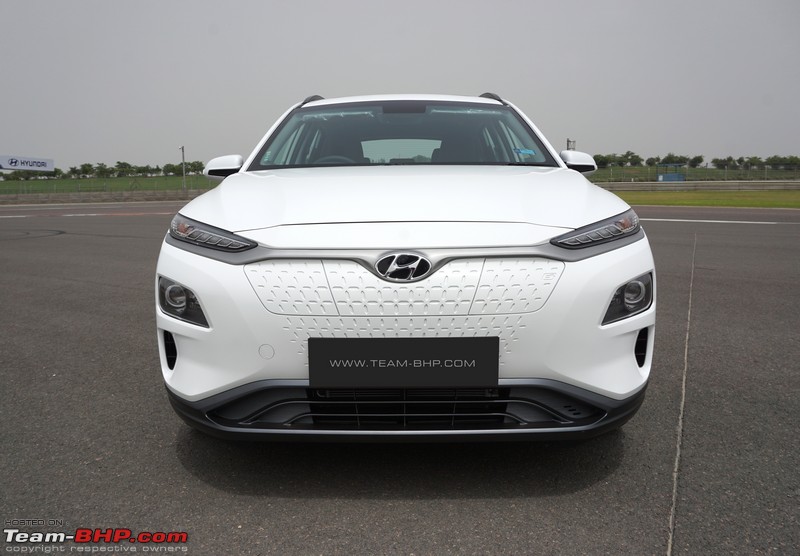 The rear gets a split light design with the taillights & brake lights at the top, and the indicators, reversing light & rear fog lamp below. The lower part of the bumper is also finished in black plastic cladding. Use of chrome is limited to the badges. The Kona measures 1,800 mm in width and 1,570 mm in height: 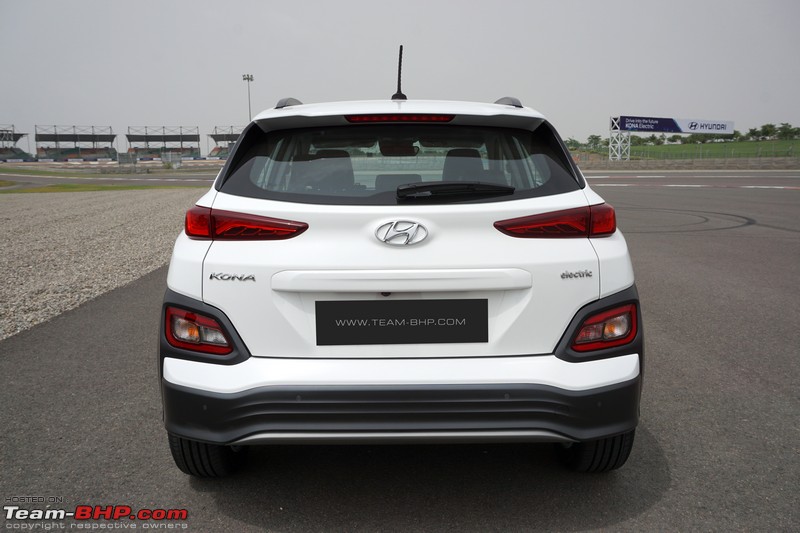 From the side, it's apparent that this advertised 'SUV' is clearly more like a crossover / hatchback. The cladding helps make it look more SUV-ish. However, it’s evident that the main selling points of an SUV - height and ground clearance, don't really feature on this car. Even the watchman at BIC expressed his concern about the ground clearance looking a little low for Indian roads. The Kona's length is 4,180 mm, while the wheelbase is 2,600 mm: 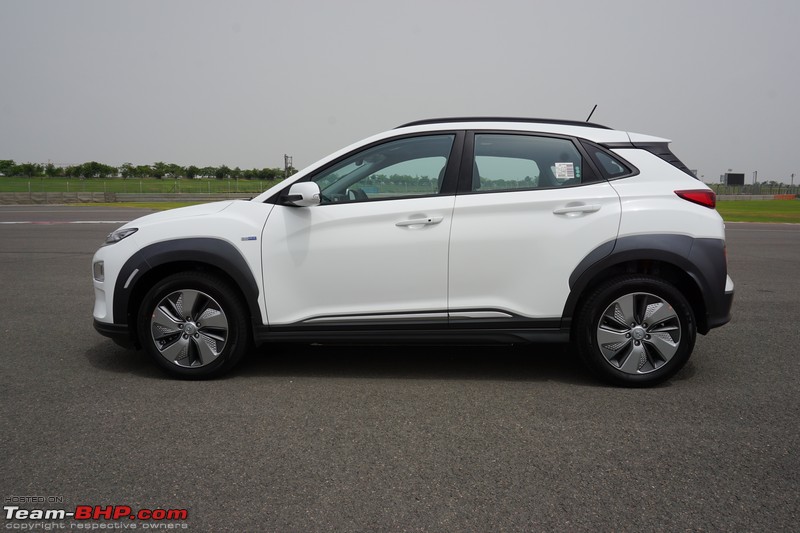 The Kona gets a lot of features designed to improve aerodynamic efficiency. Hyundai says that the co-efficient of drag for the vehicle is 0.29: 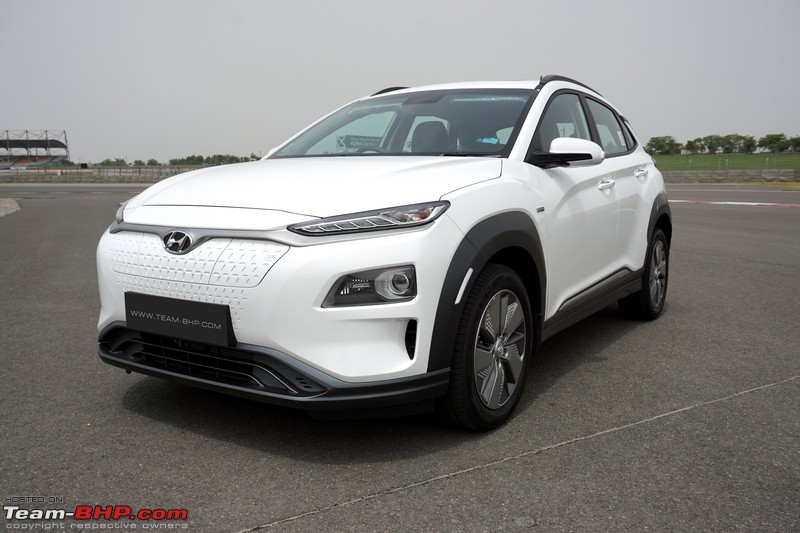 Build quality is good but not like the European cars - there are some odd panel gaps. The paint job is very good as well, but not excellent. Look closely and you might notice the orange-peel effect: 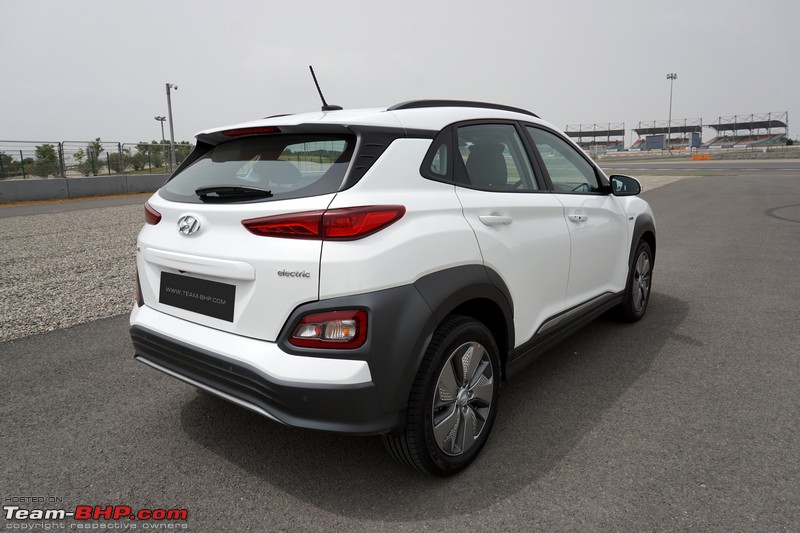 Something else that is becoming a trend nowadays is the bifurcation of the DRLs from the headlamp cluster. The 5-pod LED DRLs and indicators are placed above, while the headlights are placed below: 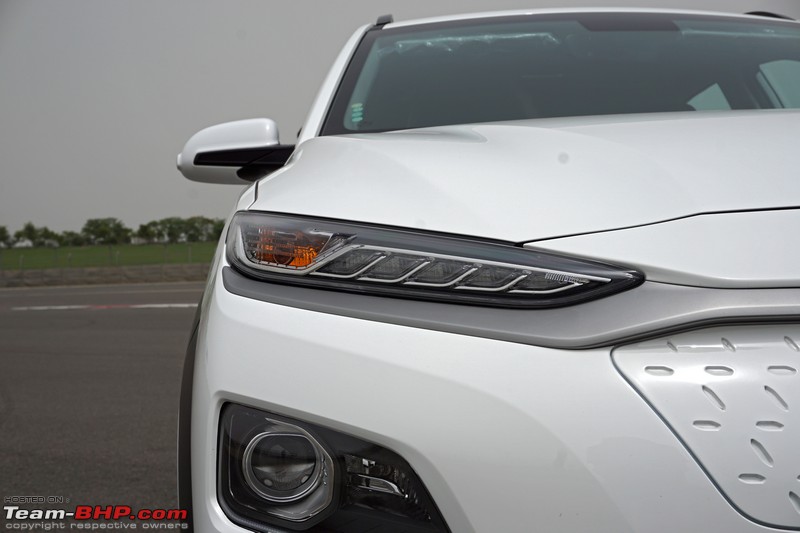 Look closely and you will find this small protrusion on the DRL cluster lens: 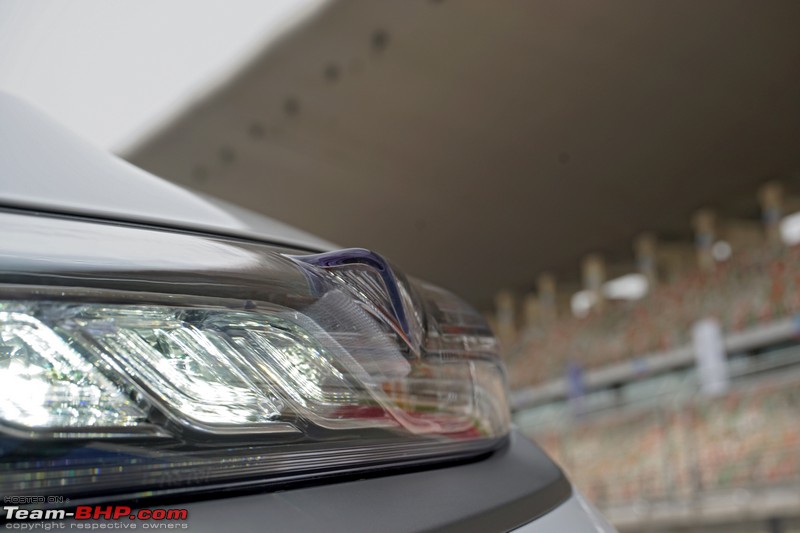 The bright and prominent DRLs make the front end look more aggressive: 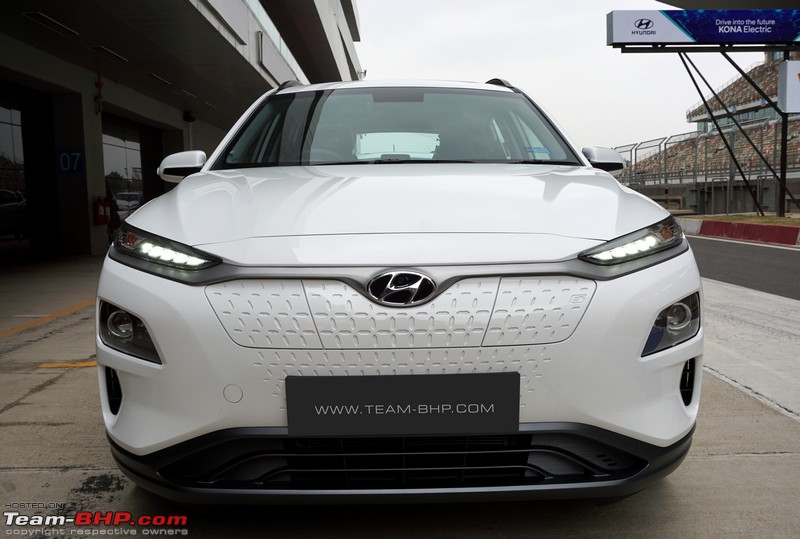 The headlight cluster in the bumper gets auto-on auto-leveling bi-functional LED headlamps and cornering lamps which activate when the front wheels are turned: 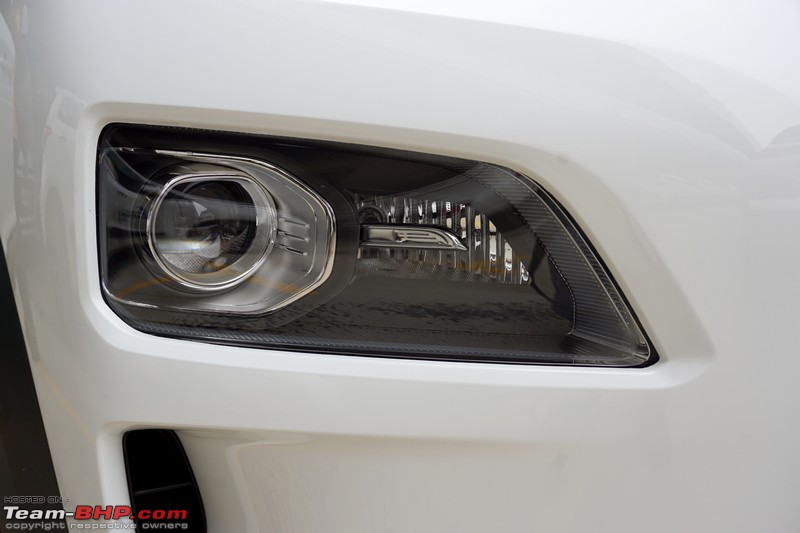 Here's a look at the headlight (white) and the cornering light (yellow) in action: 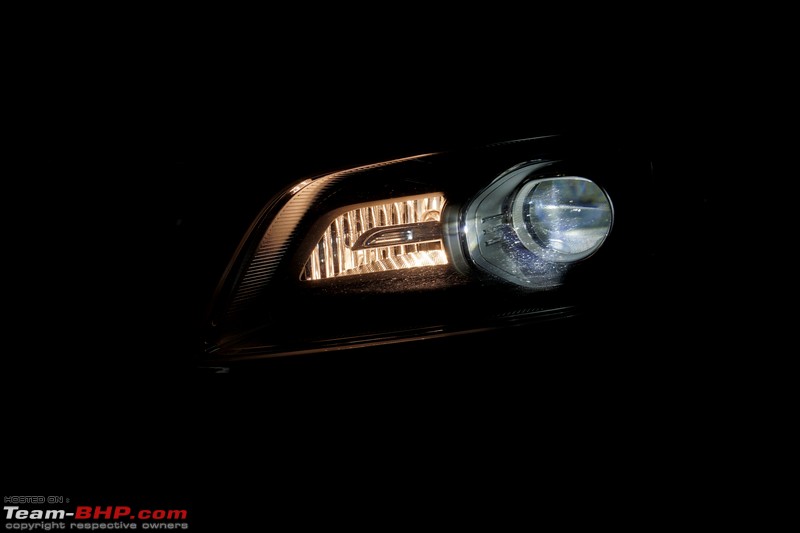 A closer look at the debossed ‘+’ motif on the grille. This will be difficult to keep clean. The front also has a silver-grey trim running the full width of the car below the DRLs and the bonnet line: 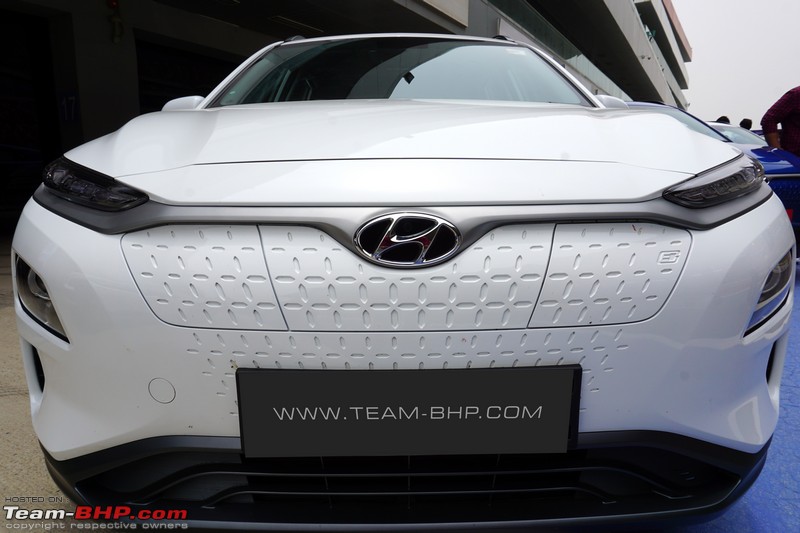 A round warning light in the Hyundai logo indicates the status of the Aux. Battery Saver+, which monitors the charging status of the 12V auxiliary battery. When the indicator is illuminated, Hyundai says that touching the high voltage electric wire (orange), connector and all electric components could cause an electric shock leading to injuries: 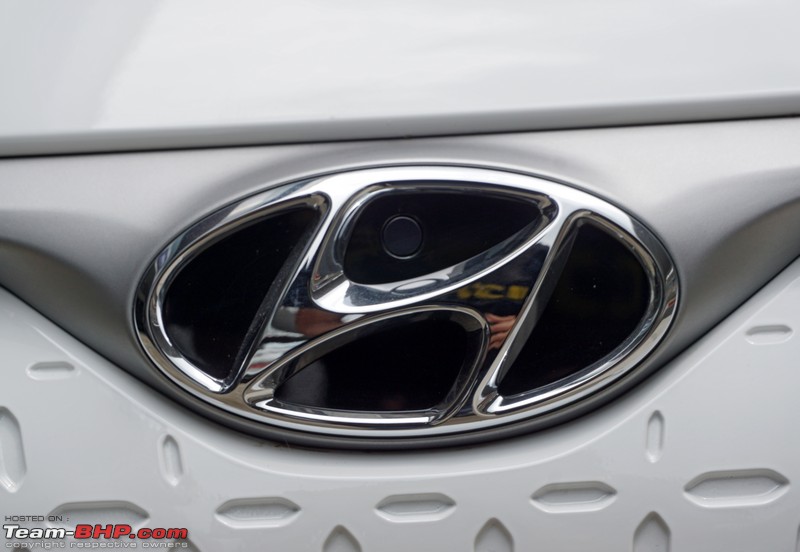 The charging port is located behind this flap on the front grille. In case of a frontal collision, the charging port could get damaged easily. We would have preferred the charging port placed elsewhere on the vehicle. The cover for the charging port gets a logo which smartly integrates the icon of a plug, as well as the letter 'E'. In order to open the charging port, put the car in P, switch the car off, and press the flap near the 'E' to open it. It can only be opened when the vehicle is unlocked: 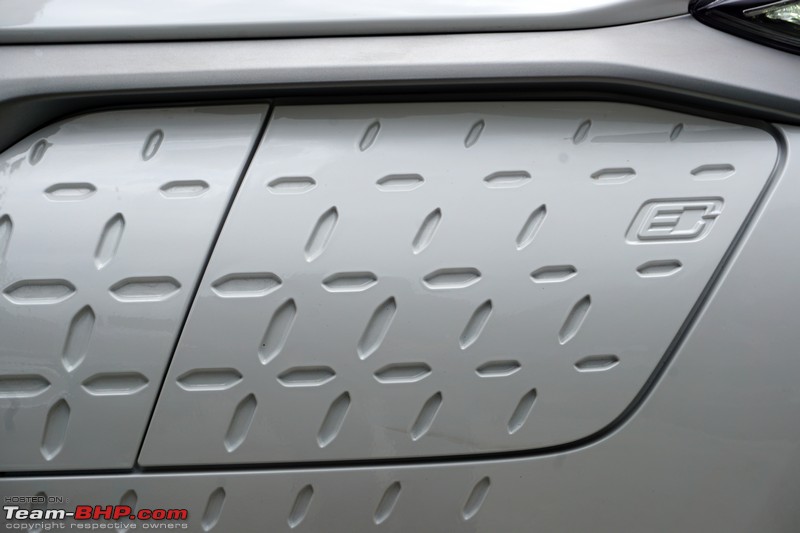 The dual tone bumper gets black plastic cladding at the bottom. Also notice the wind deflector down below: 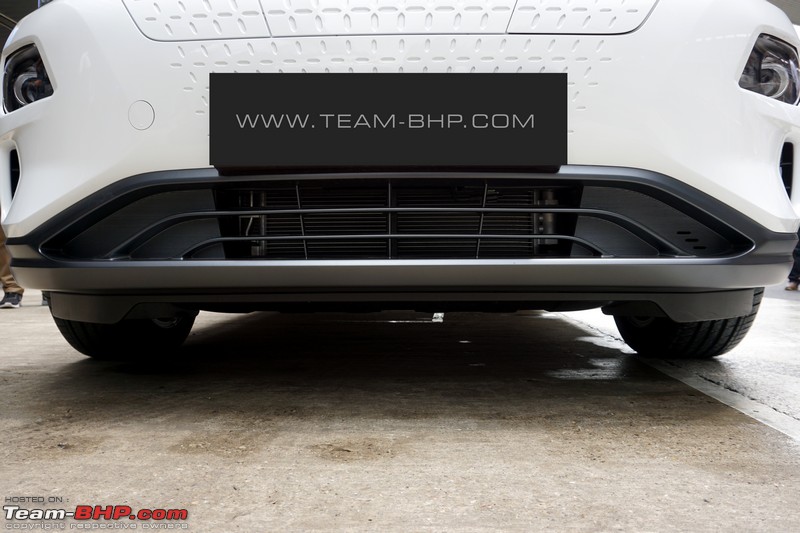 The front bumper also gets active air flaps that can open and close as required: 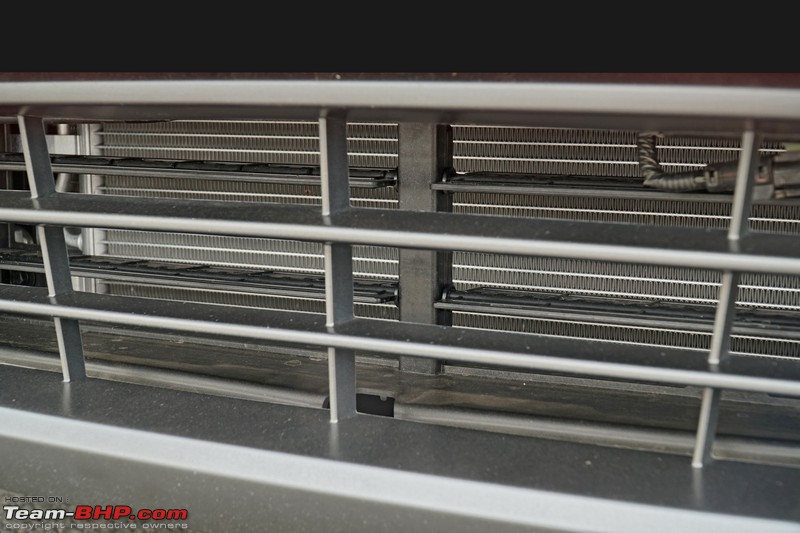 Three small slits on the left side of the bumper. We were told they were for additional airflow to internal components: 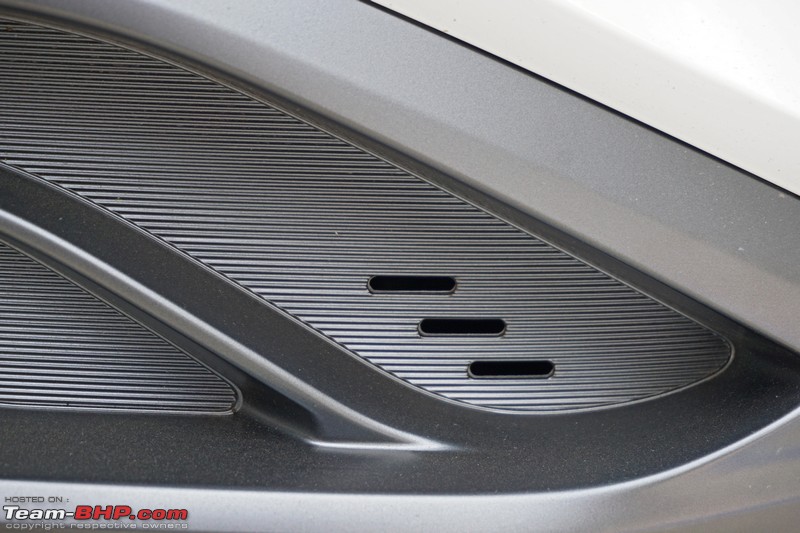 Air vents are present on both extreme ends of the bumper: 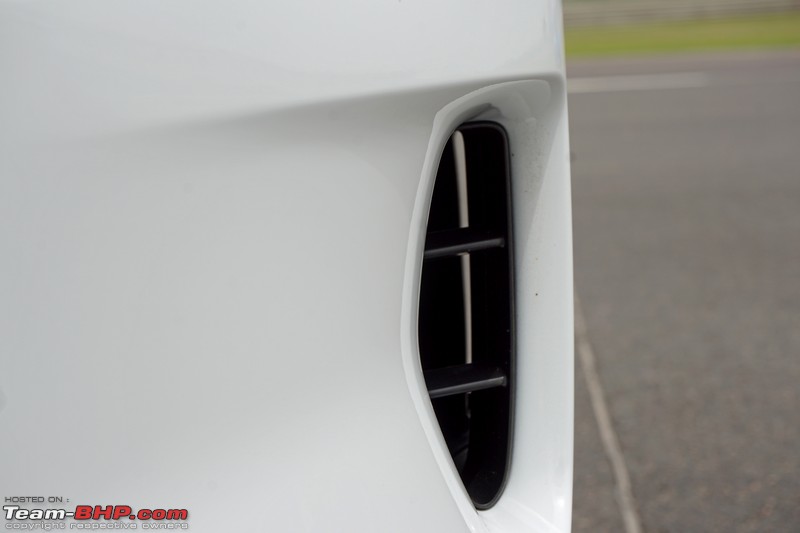 The front towing point is hidden behind this cut-out: 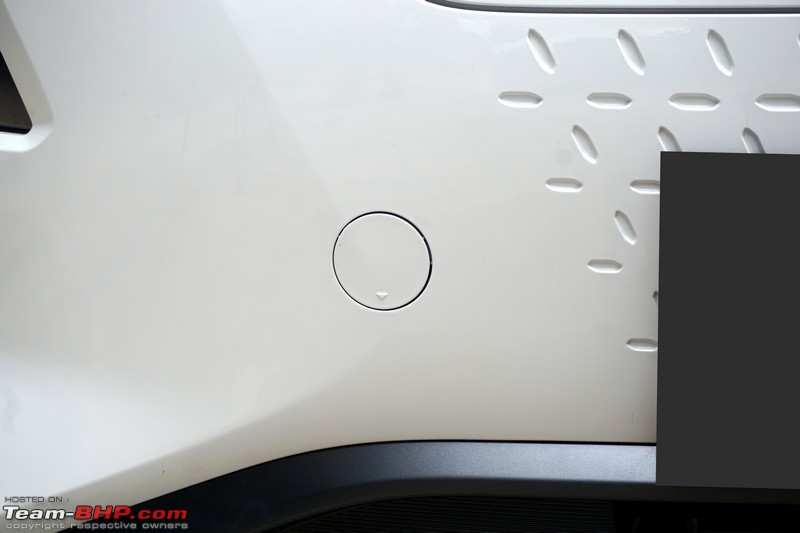 Underbody protection has been provided at the front. Due to the position of the battery pack, the underside of the Kona is extremely flat: 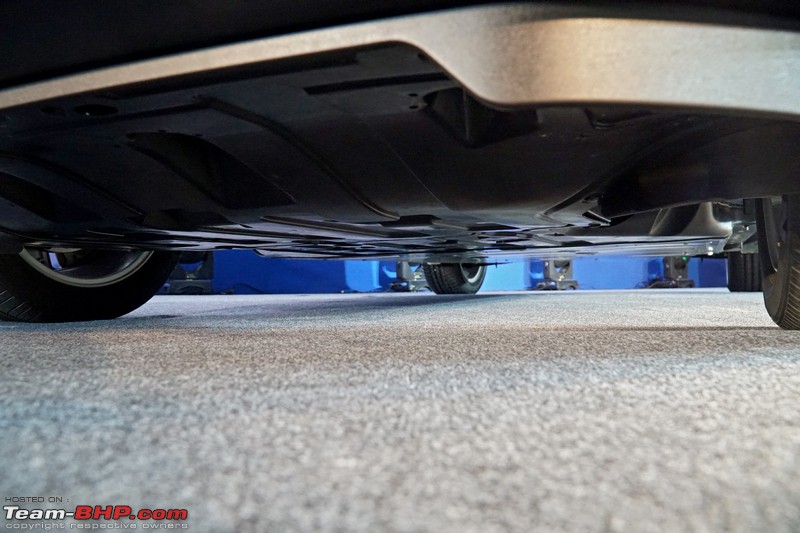 The bonnet has muscular bulges and creases that add to the aggressive look of the front end: 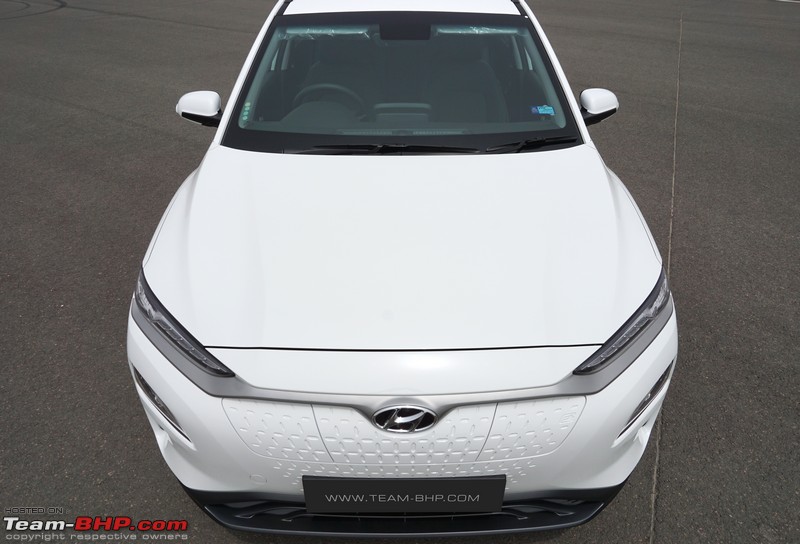 The creases on the bonnet are clearly visible here: 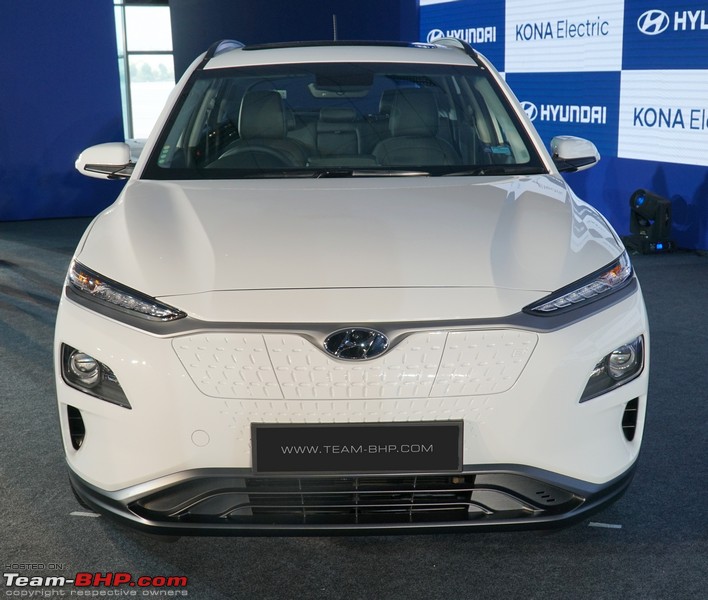 ORVMs are electrically adjustable and auto-folding. They unfold as soon as you approach the locked car with the key in your pocket: 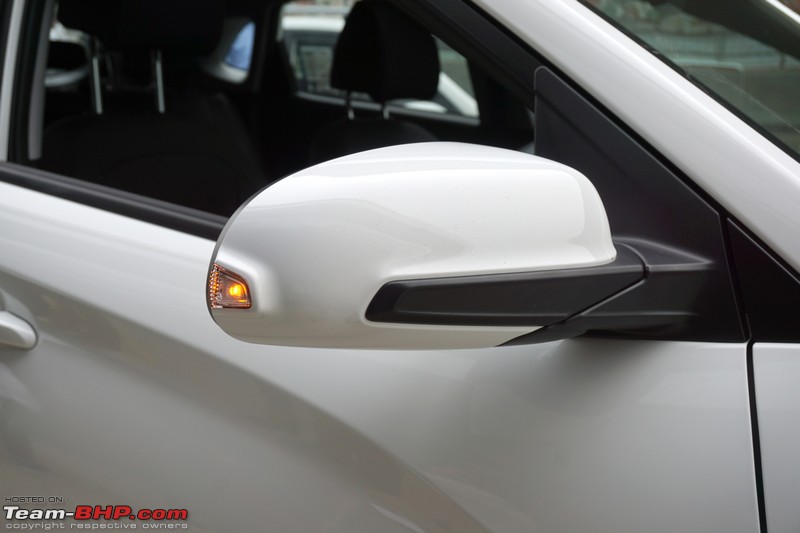 Both the front doors get request sensors: 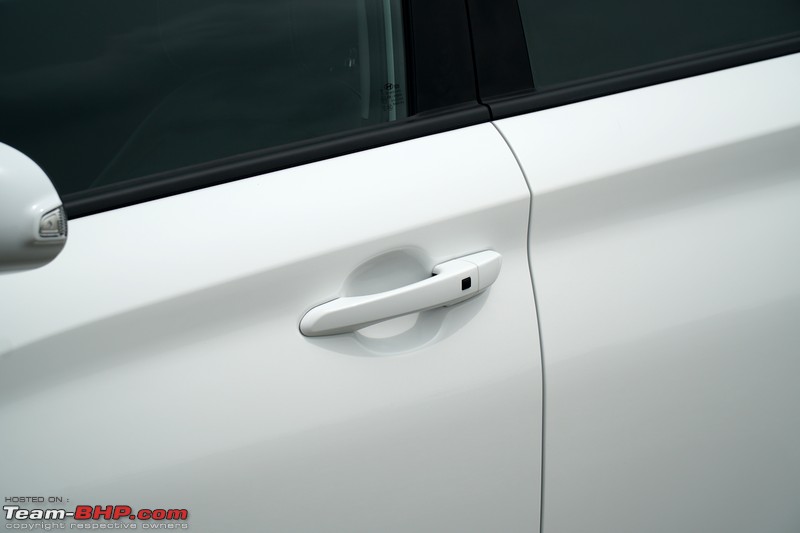 Character lines on the doors and the flared rear wheel arches add to the crossover / SUV look of the Kona: 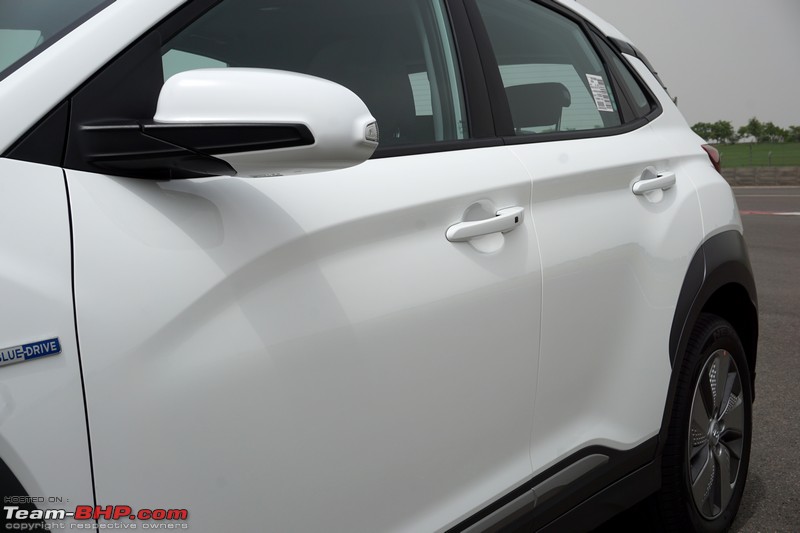 The doors get plastic cladding at the bottom, as well as a silver trim highlight:  Rear quarter-glass area is too small to make a noticeable difference: 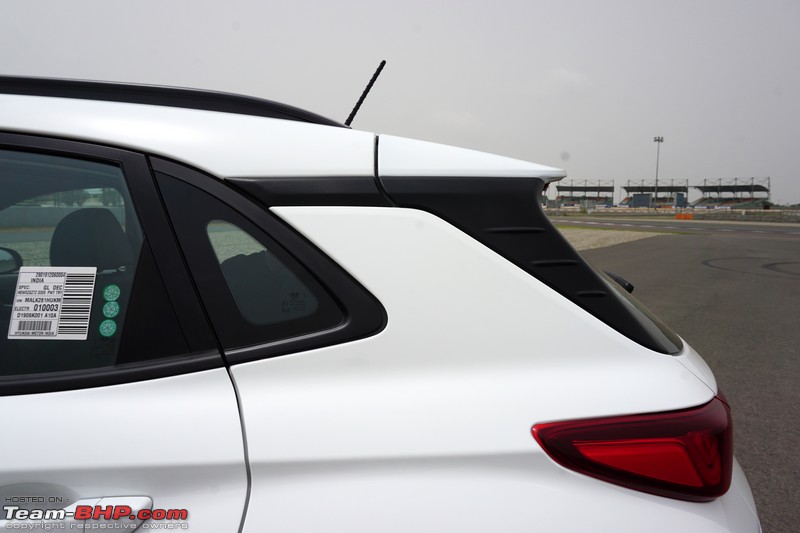 C-pillars get plastic inserts and three small aero fins at the tail end: 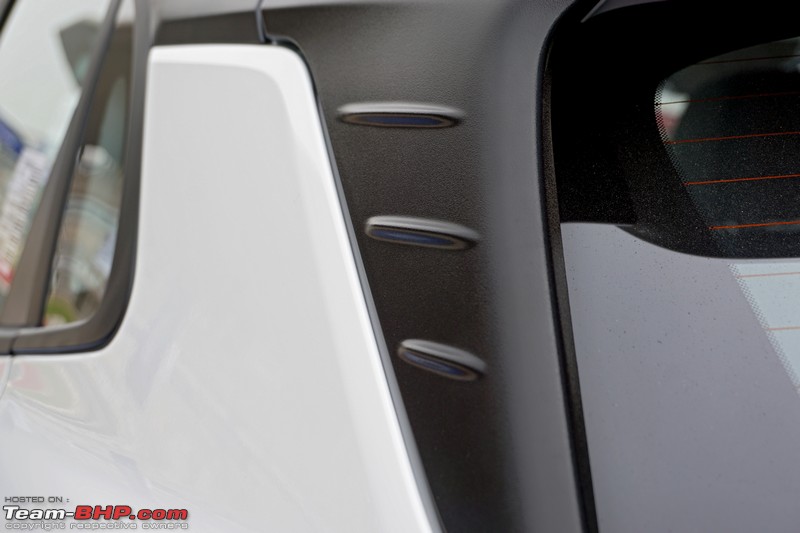 Bend down and you'll see that the battery pack hangs down below the door sills, compromising the ground clearance: 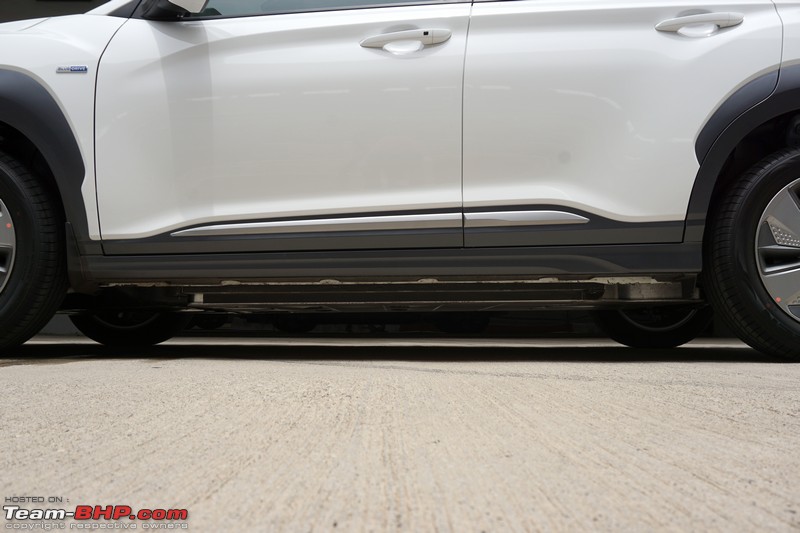 It’s unclear how much underbody protection there is for the battery pack. Hopefully, our notorious Indian roads won’t create any problems here: 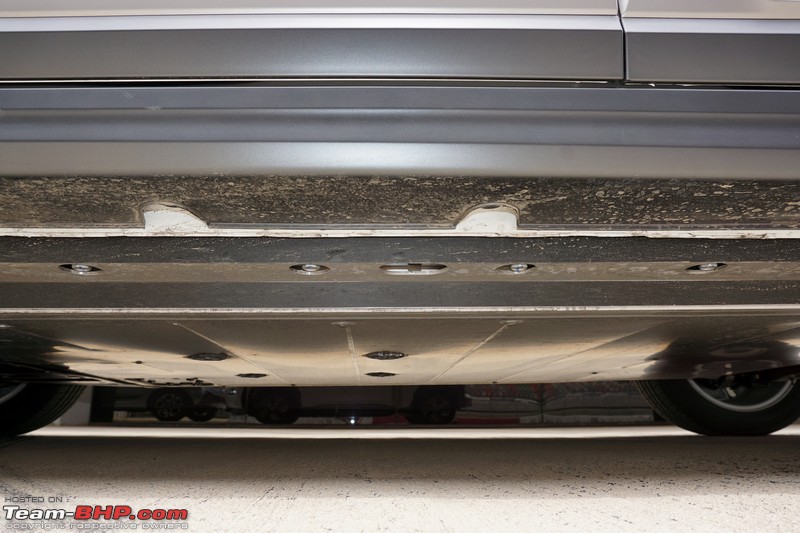 Blue Drive badging on the front fender: 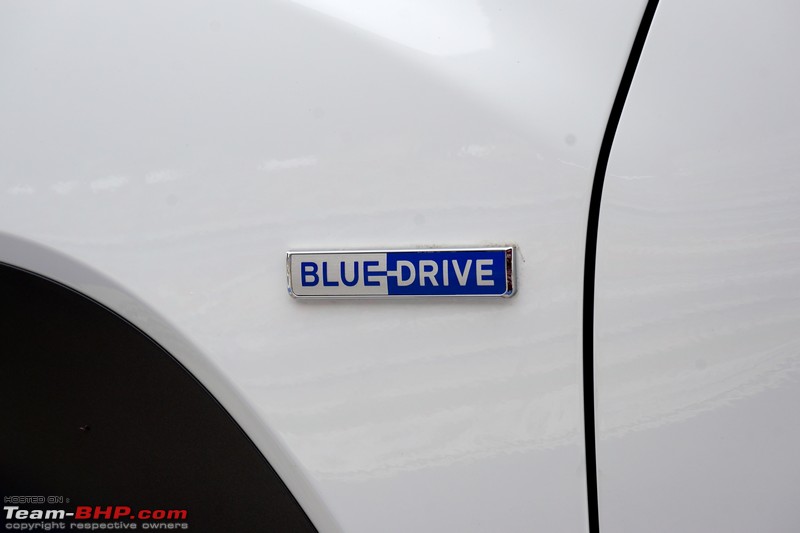 Black plastic cladding runs along the wheel arches. 17" inch alloy wheels are shod with 215/55 Nexen N'Fera SU1 tyres. The alloy wheel design is unusual and may not be to everyone's tastes: 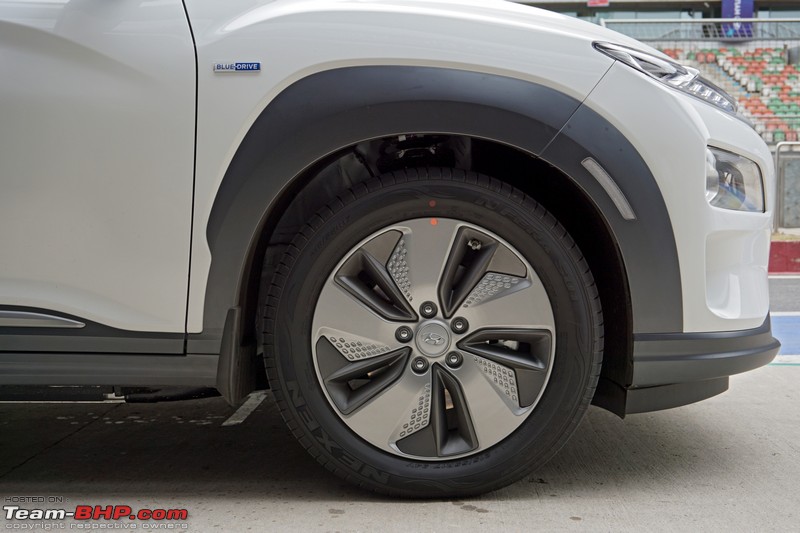 Upon closer investigation, you'll find that the darker colored-inserts are made out of plastic. These could be to aid aerodynamic efficiency without adding much more weight: 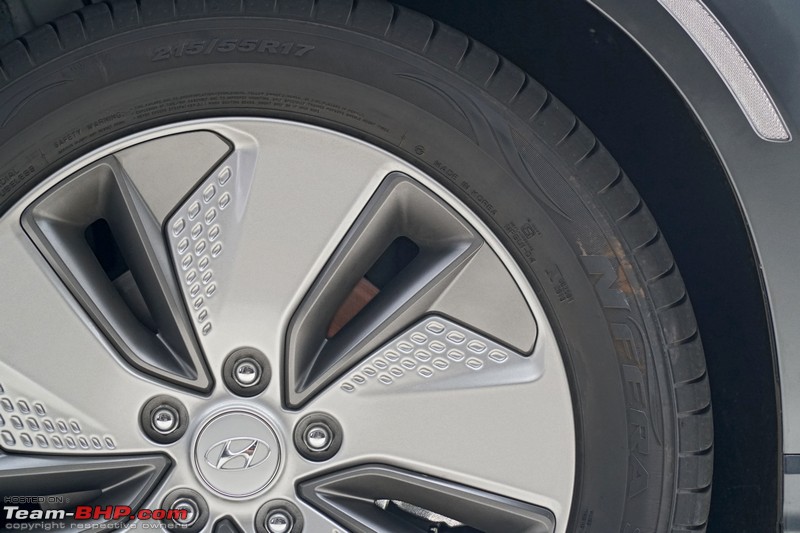 The wheel arches get these clear reflectors on both sides: 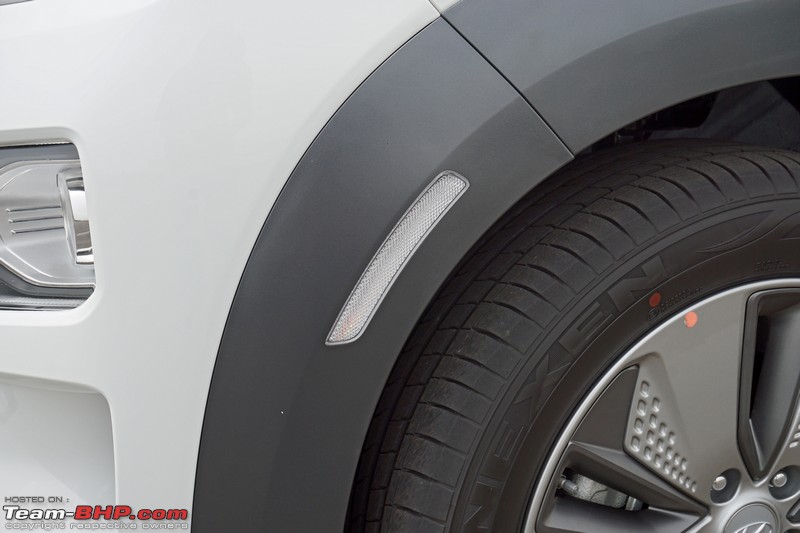 The rear wheel arches also get plastic cladding, which continues toward the rear and wraps around the lower part of the tail lights too: 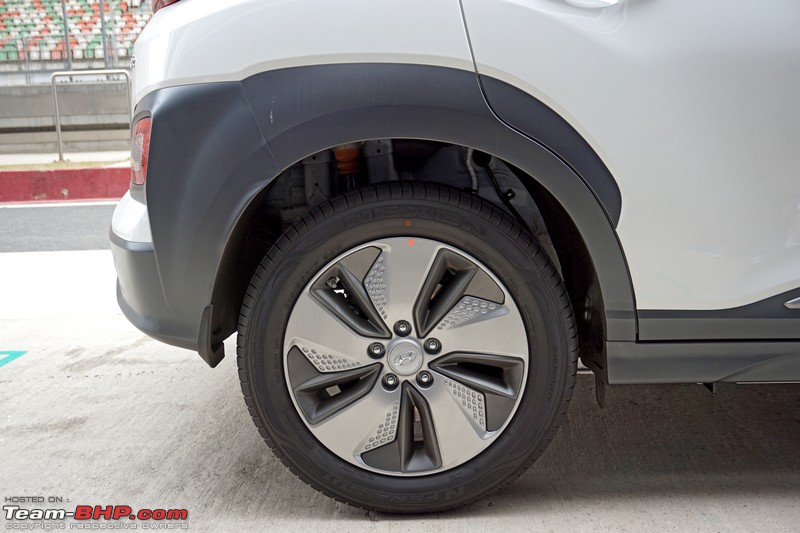 Look closely through the plastic inserts and you'll find rear disc brakes: 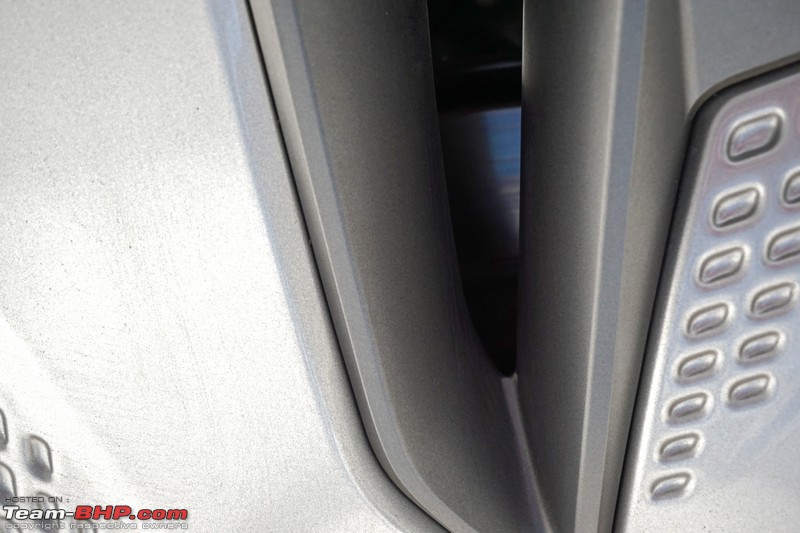 Something that Indian customers like - the Kona gets a sunroof: 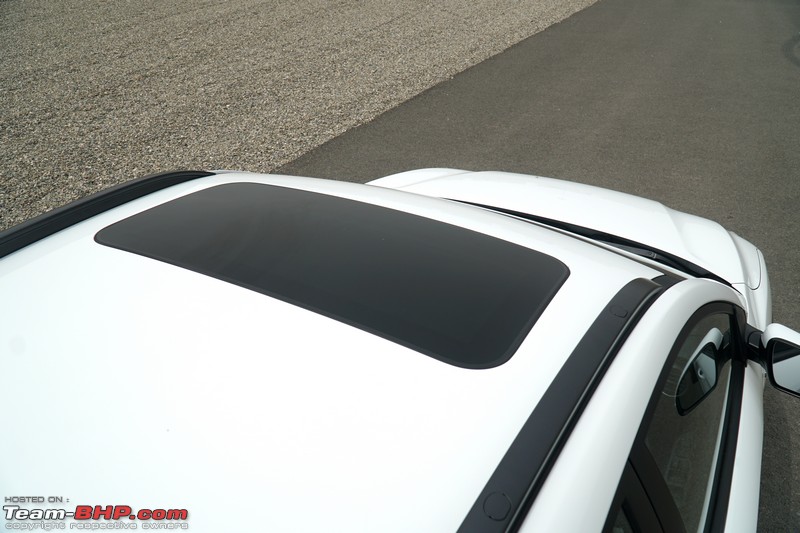 The crossover also gets black roof rails and a stubby antenna, which sits at the rear of the roof. A shark-fin antenna would have looked a lot more modern here: 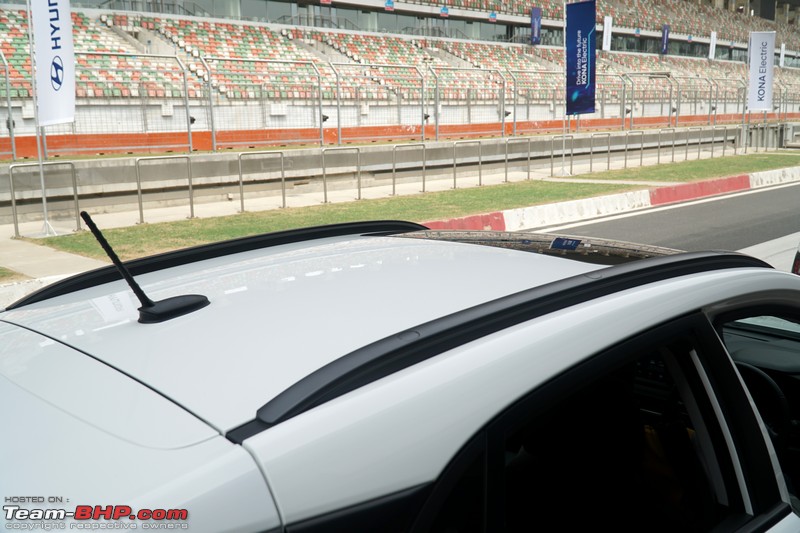 Tailgate gets a neatly integrated spoiler, which houses an LED HMSL. The tiny cut-out touching the glass is for the rear washer: 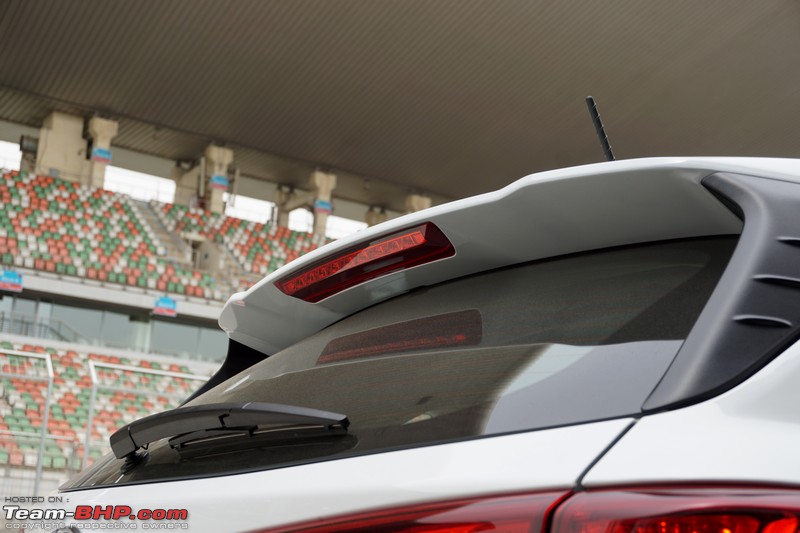 The rear gets LED tail lamps: 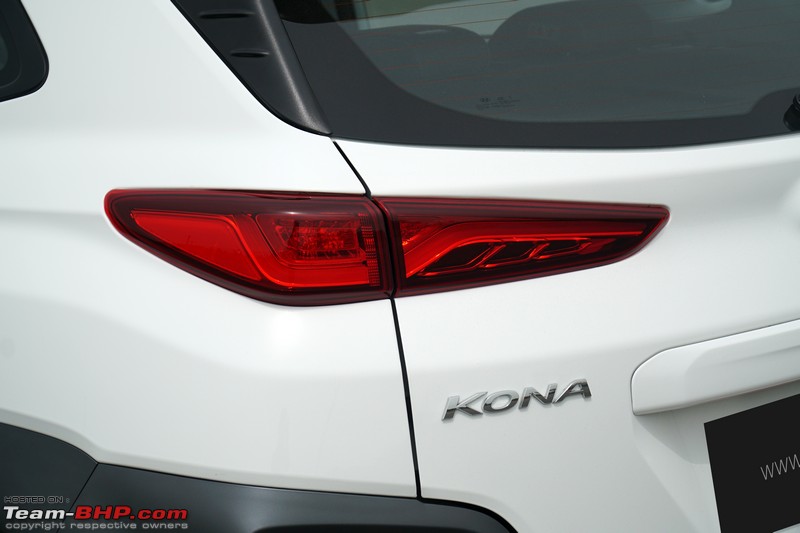 A look at the tail lights in action: 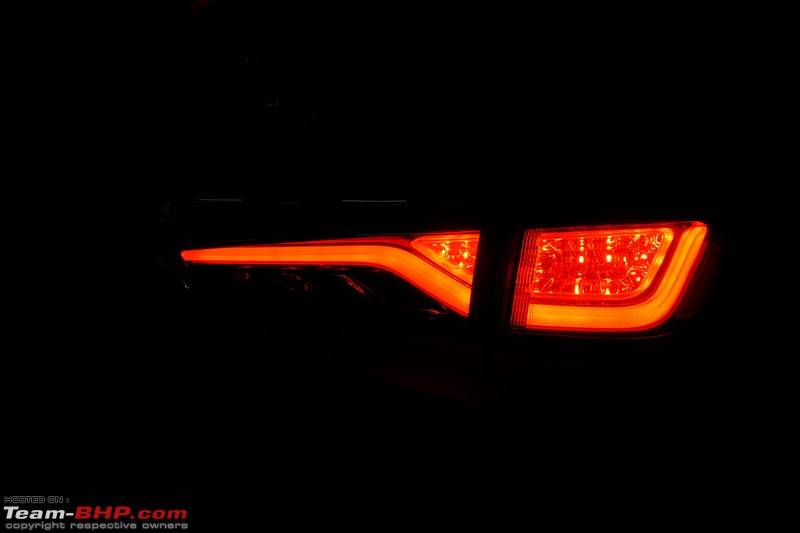 A rear washer and wiper are offered: 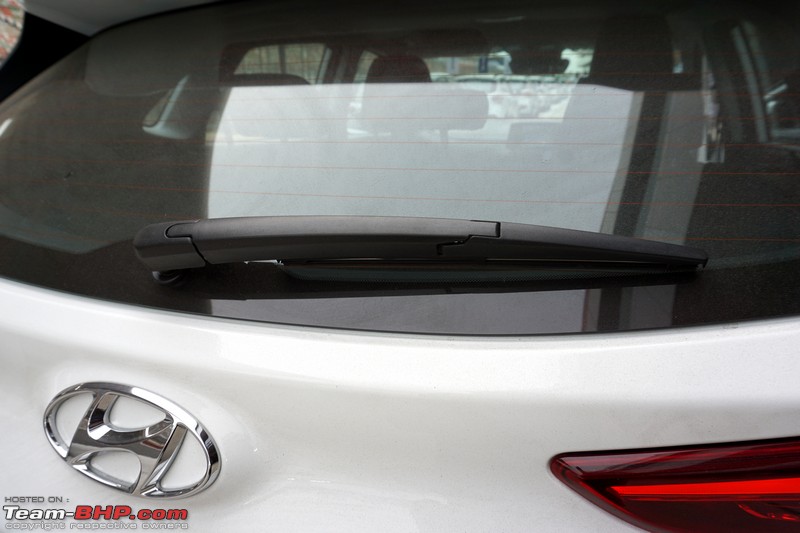 Number plate is housed in a large recessed area on the tailgate. Do note that a large chrome strip has NOT been slapped on above it: 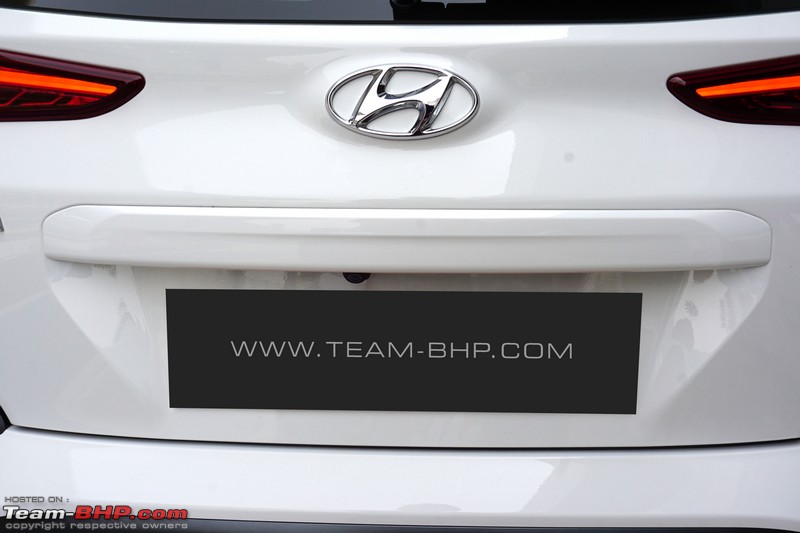 Reversing camera is tucked away, above the number plate with the soft-touch boot release button next to it: 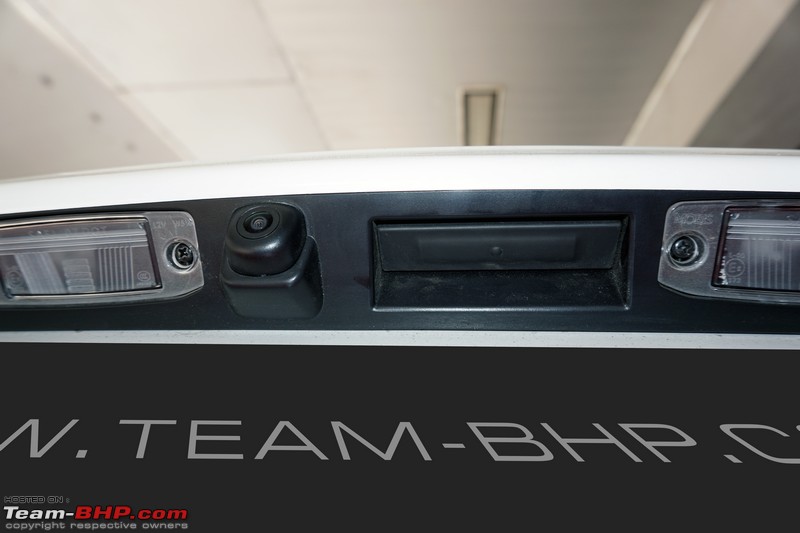 The only chrome bits on the tailgate are the 'Kona' badging on the left... 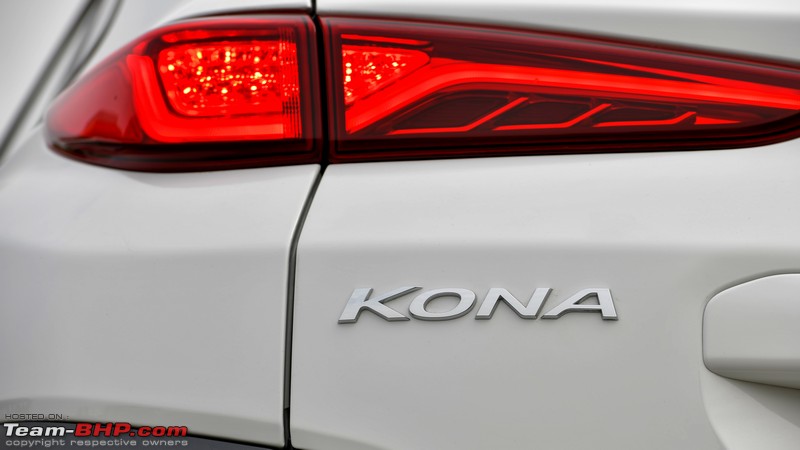 ...and the 'electric' badging on the right: 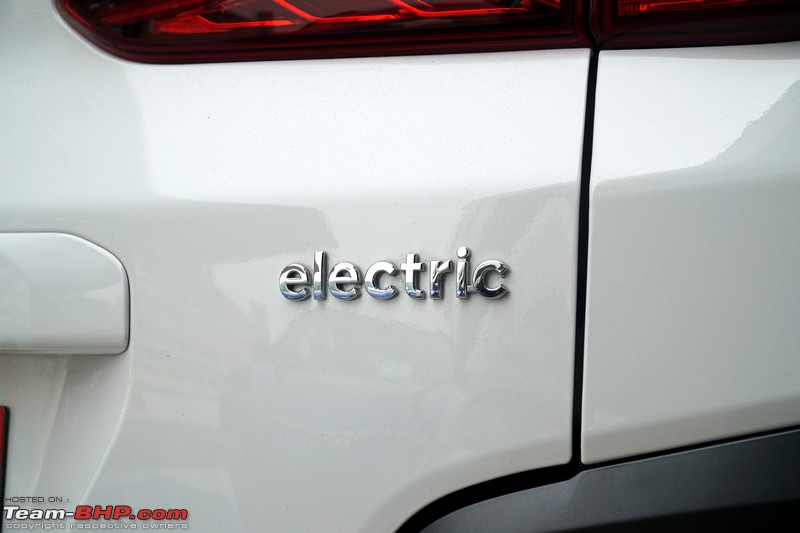 Dual-tone rear bumper has stylized creases on the plastic cladding, along with 4 parking sensors and a tow hook. The skid plate area below is silver: 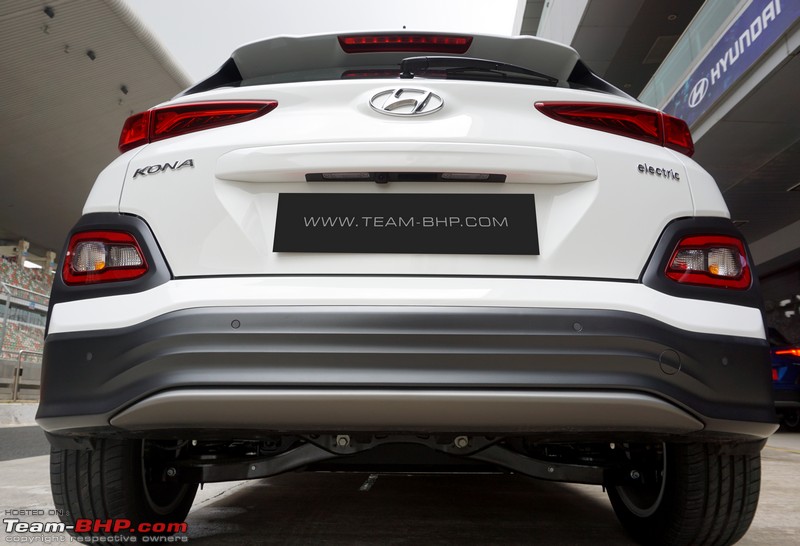 The lower tail lamp clusters are surrounded by red reflectors. In addition to the turn-signal lamp for each side, the left cluster gets a reverse lamp, while the right cluster gets a rear fog lamp. Note that the boot lid does not shut perfectly around the tail lights: 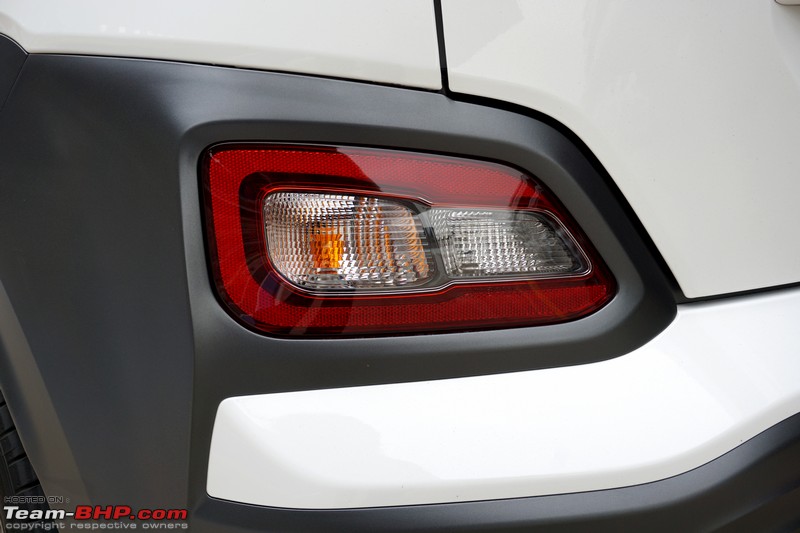 A look at the indicator in action: 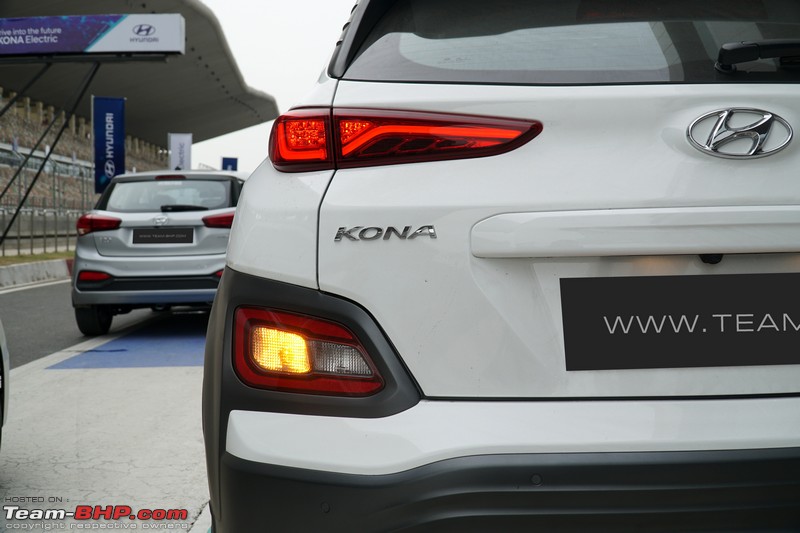 The thick battery pack can be seen clearly under the car. As mentioned before, this is a significant hindrance to ground clearance: 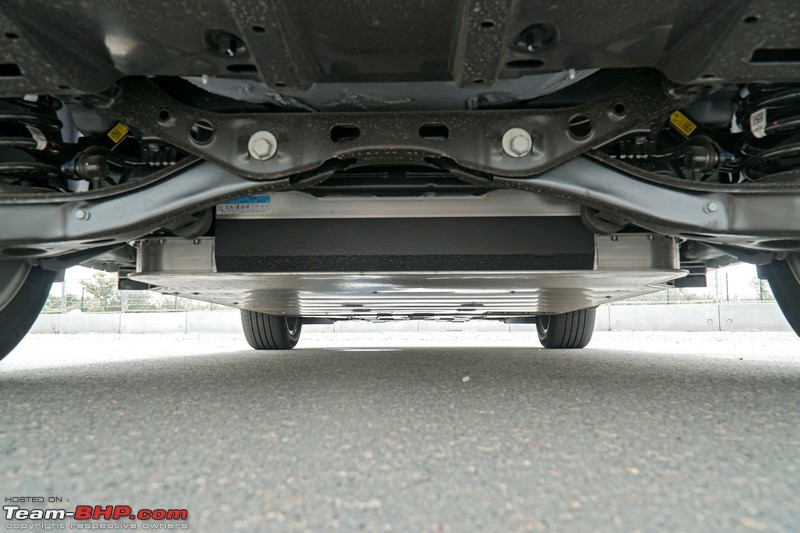 From the front, the Kona looks more aggressive than the i20. It has a lot more presence as well: 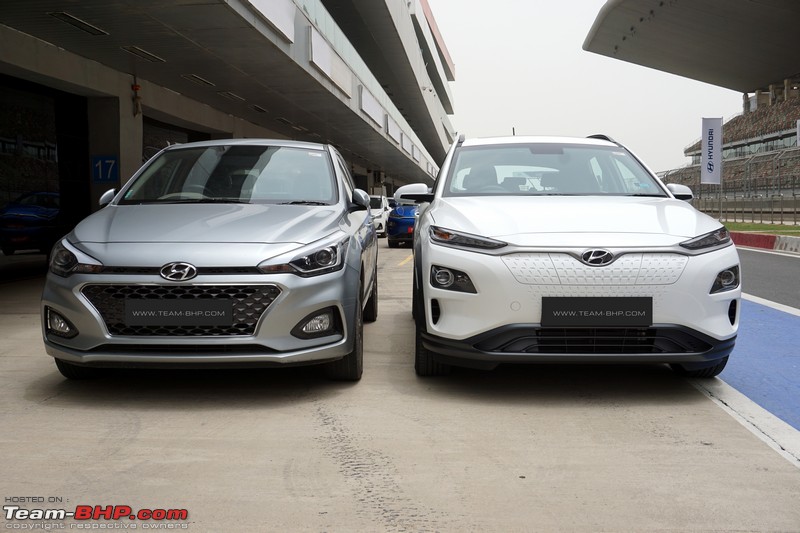 A regular fuel-powered Kona could compete in the segment just above the i20. The electric powertrain is the reason it’s priced several segments higher: 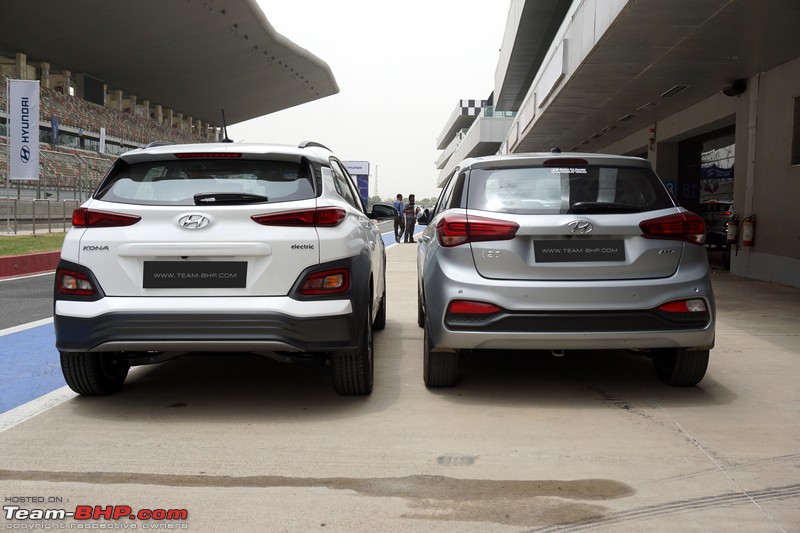 Compared to the i20, the Kona is 195 mm longer with a 30 mm longer wheelbase. The black cladding helps in giving it more of an SUV / crossover look: 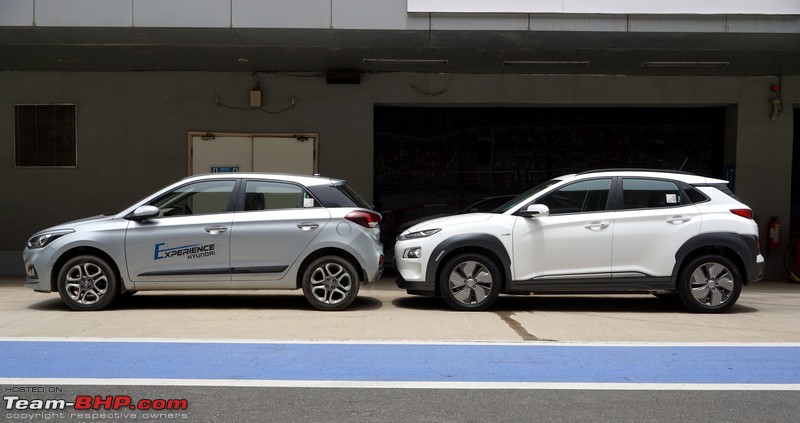 Next to the Venue: 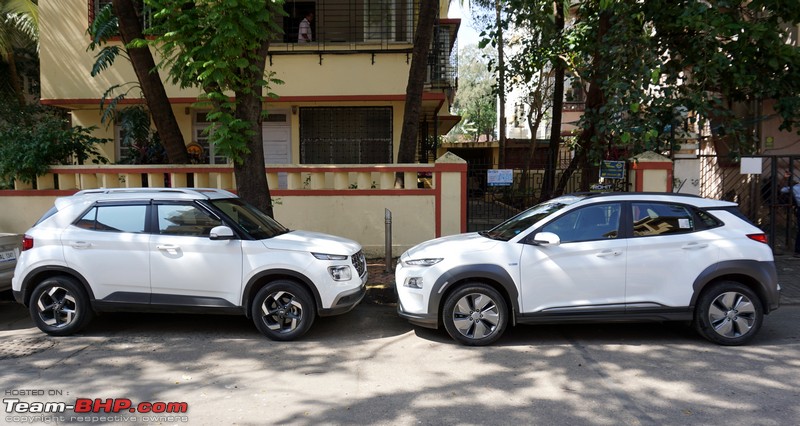 Last edited by Aditya : 15th October 2019 at 10:05. |
| |  (44)
Thanks (44)
Thanks
 |
| The following 44 BHPians Thank ChiragM for this useful post: | ach1lles, ADI7YAK, aeroamit, akshay81, autonarr, Chrome6Boy, CrAzY dRiVeR, Dani7766, Enobarbus, espraveen, Evyas, Gannu_1, gauravanekar, GTO, GutsyGibbon, hemanth.anand, InControl, jailbird_fynix, keroo1099, Keynote, Klub Class, lemedico, MSAneesh, N33raj, Omkar, phoenixash, pkirwadi, RaghuVis, RavenAvi, Rehaan, samabhi, Simat, sri_tesla, SS-Traveller, sukiwa, theexperthand, THE_DRIFTER, The_Outsider!, timuseravan, vaasu, vb-saan, Vik0728, VTec_KickedInYo, Vysakh |
| | #4 |
| Senior - BHPian Join Date: Apr 2018 Location: Bangalore
Posts: 1,546
Thanked: 17,346 Times
| Interior - Front 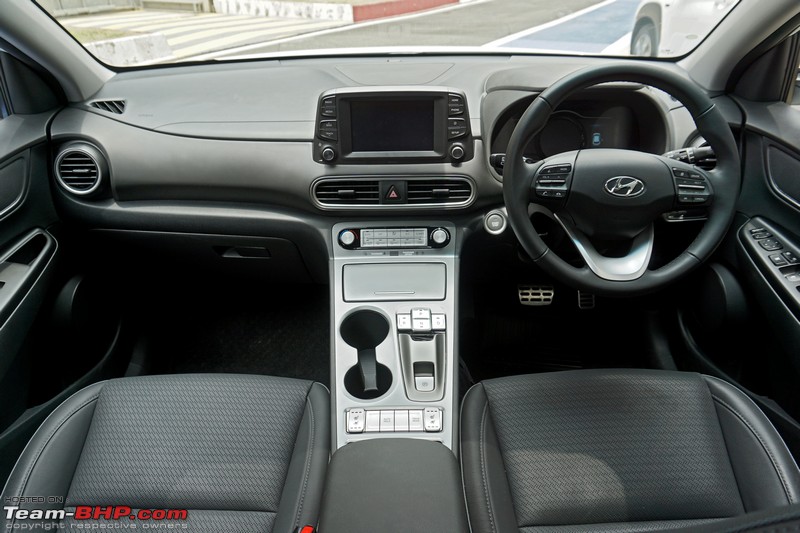 The front doors open with a 3-stage action. They feel robust, and at times require a bit too much effort to pull further open. There is no satisfying "thud" when you shut them either. It does not feel as well-built as some of the European cars. With the ingress being like you're climbing ‘into’, rather than ‘onto’, the Kona feels more like you are entering a hatchback than an SUV. Once inside, you'll find that there's sufficient legroom & headroom at the front. The functional and understated black & silver dashboard doesn’t flaunt anything futuristic. It does a good job of transitioning consumers over to an EV without making them feel like they are out of their comfort zone. Everything feels very familiar and understandable. Apart from the distinct lack of a gear lever, and a few different metrics on the MID, there isn’t anything else forcing you to acknowledge that this is an electric car. The Kona comes with a double-decker centre console, offering additional storage space below. The cabin is finished in both soft-touch material and hard plastics. While the center part of the dashboard has soft-touch material, hard plastics are present above and below it. Not something that you’d expect on a 25-lakh car, but like we said earlier, we have to account for the ‘EV premium’ when it comes to the Kona’s pricing. The Kona’s air conditioner is just as powerful as any fossil fuel vehicle, and cools the cabin quickly. However, it isn’t as bone-chilling as some of the other Hyundais (eg. Xcent). The blower has a very wide range of 8 speeds. The lowest level is quite peaceful and the top level is powerful but can still be equated to the max blower (typically level 4) on any other vehicle. The blower starts getting loud at level 4 and then gets really loud as you go up to 8. In a selectable ‘driver only’ mode, the air only flows out from the two rightmost vents. This saves battery power, and the setting is remembered even after you turn the car off and on, so that’s convenient if you are usually driving on your own. Lateral view of the dashboard:  Leather-wrapped 3-spoke multifunction steering wheel is the typical smart-looking Hyundai design. It has perfect indents for your thumbs and feels great to hold:  The steering has controls for the volume, audio and telephone on the left, while cruise control and MID navigation buttons are on the right:  Despite having a single-speed transmission, the Kona comes with paddle shifters. The paddles come with the unique function of controlling the aggressiveness of the regenerative braking. The paddle on the left increases the intensity of regenerative braking (think of it like down-shifting), while the paddle on the right decreases the regen intensity. What’s more, you can bring the car to a complete halt without pressing the brake pedal by simply pulling and holding the left paddle:  Steering has rake & reach adjustment. It has a huge range of travel which greatly helps in finding a good driving position:  The engine start/stop button comes with blue back-lighting and a silver surround. It also gets a coloured indicator light to show which mode the ignition is in:  The 7.0-inch digital instrument cluster comes with a power / charge indicator on the extreme left – which indicates the rate of power drawn or regenerative charging. The extreme right displays the battery charge level (a more exact percentage readout is available on the AVN screen). The instrument cluster also gets a MID, and the speedo display changes depending on the driving mode you select:  Here's a look at the instrument cluster on startup:  The MID gives various information including tyre pressure and power consumption. The MID also shows the odometer reading and the outside temperature. In Eco mode, it turns green and displays an ECO symbol and the remaining range:  The various settings that can be changed in the MID: 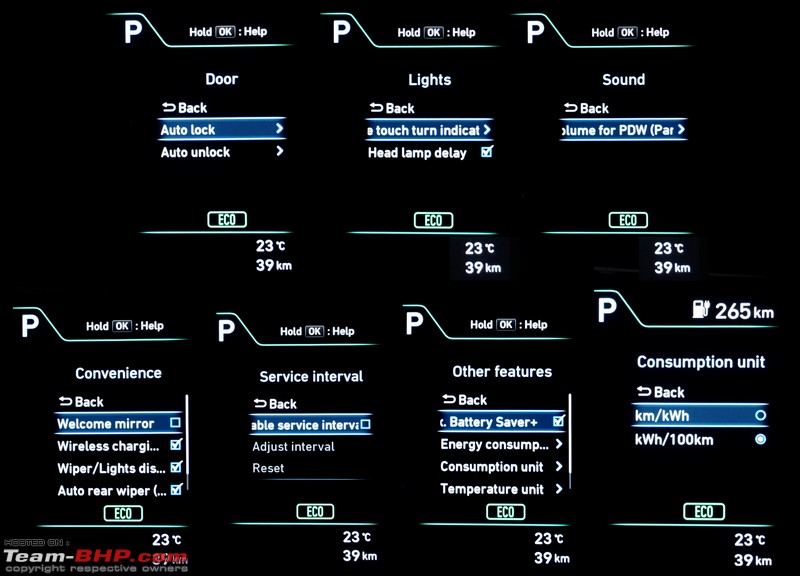 The MID display shows which door is open. When the bonnet, sunroof or the boot are open, they flash red. A separate verbose warning is present for when the charging flap is left open:  The stalks feel solid and are great to use. The vertical silver trimline looks nice. However, the stalks have prominent flash-lines that can be felt where the two plastic pieces are joined. Wipers have five intermittent settings that snap into place with a satisfying little click. Sadly, no auto wipers. You do get auto headlamps though. Fog light is a toggle switch integrated on the RHS stalk. You just push it down, it bounces back up:  Circular air vents on the sides get a silver surround. All AC vents can be shut off completely by angling them all the way to the right:  Switches for traction control, VESS, auto charging-cable unlock, and interior illumination adjustment. Many blank spaces stick out like a sore thumb in a car at this price point:  OBD port is located at the base of the fuse box. Hyundai’s usual ‘master On / Off' switch for the electricals has been provided too:  Long and slim bonnet release lever is sturdily built and easy to grab:  Like the dashboard, the door-pads get a black colour theme with splashes of silver. They are finished in hard plastics at the top & bottom, and soft-touch material is used in the middle:  Door handles are finished in silver and they get a silver surround too:  The driver's and front passenger's windows get one-touch up / down and anti-pinch functionality. Door mirrors are electrically foldable, with an auto setting too:  The door pads can hold a 1-liter bottle, as well as other small items:  Front seats are draped in black leather upholstery and the seats are comfortable. The floor pan is high but it doesn’t make it difficult to find the right seating position. The only thing that might be a concern is if you are a taller driver, as soon as you start moving the seat up, you are going to run out of headroom. As a 5’9” driver, Rehaan had 2-3 inches of headroom to spare. Side bolstering, as well as under-thigh support is good. Both the front seats are ventilated (and heated) which is a HUGE boon in our tropical conditions:  The driver's seat is 10-way power-adjustable. The lumbar support is fixed at the perfect height, and has a huge range for its in & out movement:  A look at the perforated leather upholstery. Perforated material is mandatory for the seat's cooling and heating functions: 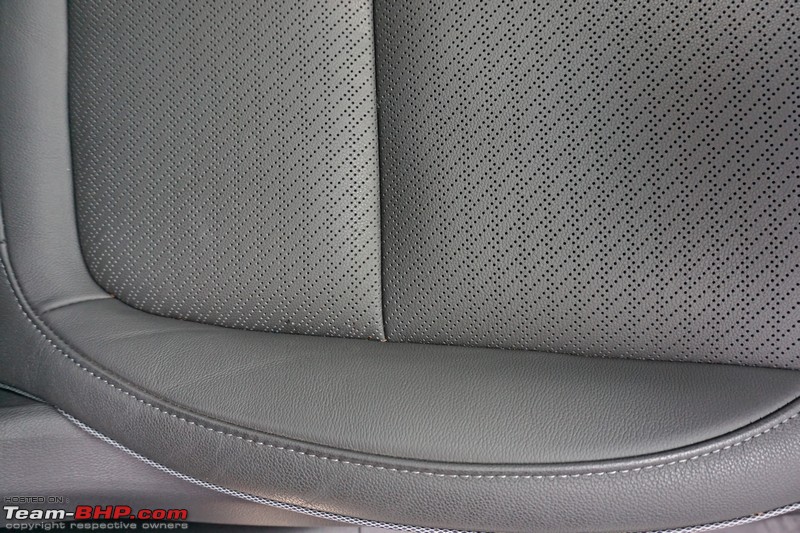 While the driver's seat is power-adjustable, the front passenger seat has manual adjustment:  Front seatbelts are height-adjustable: 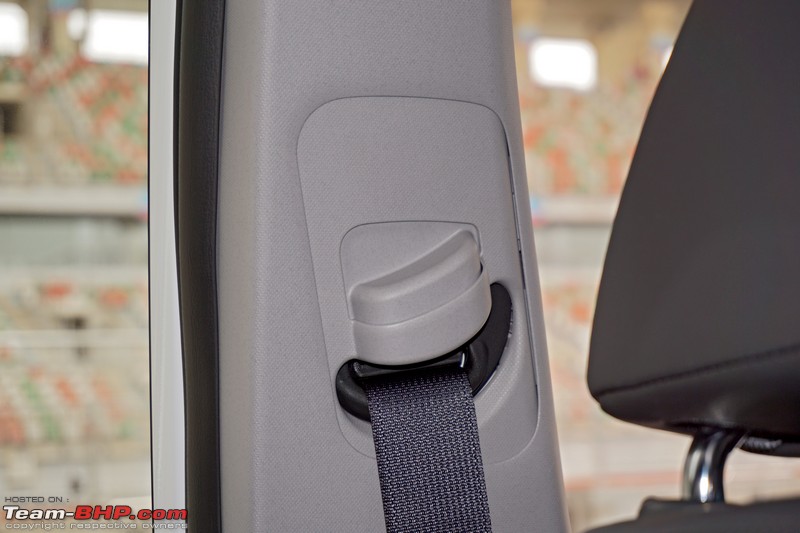 Sporty looking pedals are well spaced out. Dead pedal provided as well:  ORVMs are really tall & wide, providing a good view of things behind you:  Electrochromic IRVM is wide enough to cover the entire rear windshield. Thick C-pillars restrict visibility though:  Center fascia features a touchscreen that sticks out at the top:  A closer look at the split center console design:  7.0" floating touchscreen head-unit has been covered in a separate post later in the review:  Rectangular air vents get round corners and a silver border. The button for the hazard lights is placed in the center:  Climate control module gets a piano black insert and two circular knobs on either side for temperature and fan speed controls. The buttons related to cooling get a blue indicator light, while the ones for heating get an orange light. The beauty of an electric car is that you can run the AC whilst stuck in traffic without feeling guilty about unnecessarily spinning a huge fuel guzzling engine. Another great feature is the “Driver only” option that minimizes the AC’s battery drain if you’re the only person in the car: 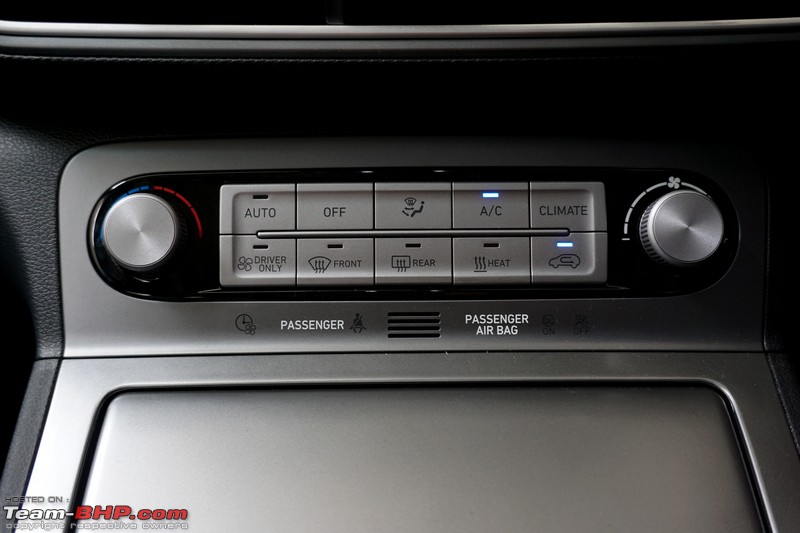 The center console gets an indicator for the Qi wireless smartphone charging (the charging pad is on the right). A USB port and an AUX-in port are provided next to it:  The ports are backlit in blue. Convenient:  Two cupholders of different sizes are located in the center console. The one towards the rear is deeper:  There's no gear knob in the Kona. Instead, it gets buttons for Drive, Reverse, Park and Neutral. Only the Park button gets a texture on it, making it easier to find than the other buttons. However, it’s still not something you can use easily without looking. We felt that having such a large button for neutral is unnecessary. It is rarely ever used, and Hyundai could have simplified things by making it much smaller, or even hiding it away:  The letters are backlit in blue, while the currently selected mode displays an orange indicator light:  The electronic parking brake switch has been placed behind the transmission buttons. The space between the transmission buttons and the parking brake is raised with a piano black insert at the front. The activation and deactivation of the handbrake can be heard inside the cabin as an electric whirring sound:  The center console also houses buttons for auto hold, drive mode selector and the cooled and heated seats. Cooled front seats are one of the best features to have in India. Props to Hyundai for equipping so many of their cars with it:  There's a small storage compartment in front of the center armrest: 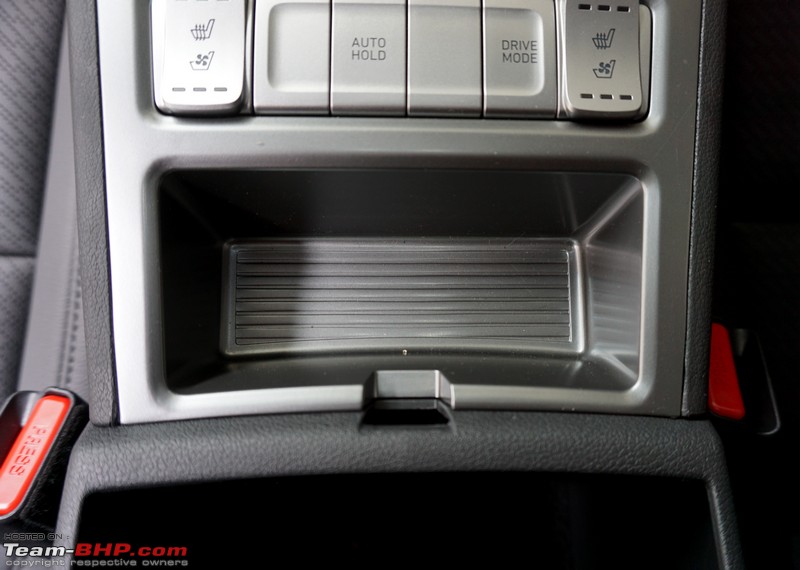 Storage under the center armrest. The bottom has a foam lining:  The lower part of the dual-level center console houses a storage area, as well as a 12V socket and a USB port:  The USB port is backlit in blue:  Medium-sized glovebox is neither cooled nor illuminated:  Roof bezel consists of a compartment for your sunglasses, map lights, and sunroof controls. You can also choose the setting for the activation of the interior lights from here:  Felt-lined holder for your sunglasses:  The Kona gets 6 airbags including dual front airbags...  …side airbags (please don't use seat covers)… 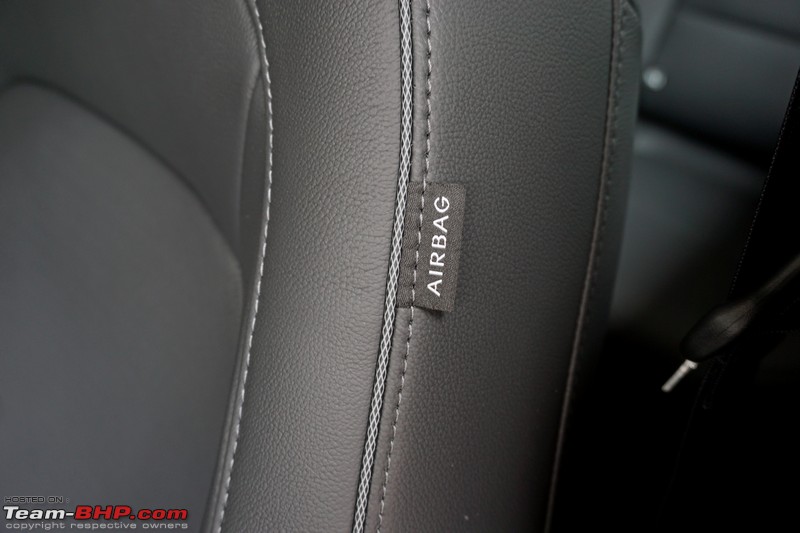 …and curtain airbags:  The sunroof is wide, but not very deep. The lower cover has to be moved manually:  Last edited by Aditya : 15th October 2019 at 10:07. |
| |  (30)
Thanks (30)
Thanks
 |
| The following 30 BHPians Thank ChiragM for this useful post: | 2himanshu, aeroamit, akshay81, autonarr, Chrome6Boy, CrAzY dRiVeR, Evyas, Gannu_1, GTO, hemanth.anand, jailbird_fynix, keroo1099, Keynote, Klub Class, Moto$apien, MSAneesh, phoenixash, RaghuVis, RavenAvi, Rehaan, Reinhard, Simat, SS-Traveller, sukiwa, swiftnfurious, theexperthand, The_Outsider!, vb-saan, VTec_KickedInYo, Vysakh |
| | #5 |
| Senior - BHPian Join Date: Apr 2018 Location: Bangalore
Posts: 1,546
Thanked: 17,346 Times
| Interior - Rear The rear doors of the Hyundai Kona open and close in a two stage action. The floor pan is very high and ingress is kind of awkward because you are stepping onto a pretty high floor whilst at the same time, trying to lower yourself down onto the seat:  Like the front door-pads, the rear door-pads get a black color scheme. They are finished in hard plastics at the top and the bottom, and soft-touch material is present in the middle. The rear windows do not get one-touch up / down feature:  Doorpad can hold a 1-liter bottle, and other small items:  The rear seats are best suited for 2, not 3 passengers. Even though the rear window sills are high, the cabin is airy. The sunroof is too far forward and doesn't provide any benefit for the rear passengers at all. Three headrests are provided:  The rear seat upholstery gets the same perforated material, despite not having any ventilated functionality:  ISOFIX child seat anchors have been provided on both sides:  While the rear seat certainly doesn’t have the kind of legroom or headroom you’d expect from an ‘SUV’, we wouldn’t consider either of these deal breakers. You could also say “it has more legroom than a 5-series” and “more headroom than a CLA-Class”. However, there certainly is one large fly in the ointment - the noticeably high floor board (due to the battery below). It results in a knees-up sitting position resulting in a lack of under-thigh support, even for shorter passengers. It would be acceptable only for small kids. Take note that this seating position can become uncomfortable very quickly for people suffering from lower back problems. Headroom is liberal. Rehaan @ 5'9", had a good 2" of clearance, though the i20 headroom is half an inch more than the Kona. The i20 also feels roomier than the Kona, as the Kona has a dip in the roofline to accommodate the sunroof internally, and the raised double-decker centre console visually eats into the cabin space too:  Although the legroom in the Kona is good, the i20 has about 2 inches more legroom. Even though the Kona has a longer wheelbase, the rear feels slightly less roomy than in the i20:  You can see how high the floor is here:  Sliding your feet under the front seat is not something most people do, but given that there is no under thigh support, you tend to want to stretch your legs forward. And that’s when you will notice that there’s no space under the front seats (unless the driver’s seat is towards the absolute top of its height range). With the seat in the absolute lowest position, you can’t squeeze more than your toes under there. The high floor due to the battery pack below is the cause of this once again:  Adjustable headrests at the rear are on the harder side:  Rear centre armrest has two cupholders:  The seatbacks are not scooped out. Instead, they have a molded hard plastic cladding. The lower third is covered in an elastic net for storing loose items:  Rear cabin lamp follows the lead of whatever the setting is for the front cabin lamp (on, door or off). It can also be turned on individually by pressing its own button:  The floor hump is not tall, making it easier for the middle passenger. However, the center console reduces the legroom available:  Quarter glass behind the rear window is tiny, and plays a greater role in the aesthetics of the car, rather than affecting the ambiance in the cabin:  Pull these levers in order to fold the seatback forward:  The rear parcel tray is large and is recessed deeply enough to keep items in place:  Boot is just 332L in size. A useful net is provided:  The Kona gets 60:40 split rear seats:  With both seats folded down, the boot capacity increases substantially:  Anchor points for child seats:  Storage space on the right to store small items. The other side gets a boot lamp:  Spare tire is a 17" 135/80 space saver with a speed limit of 80 km/h. The jack is mounted below:  Last edited by Aditya : 15th October 2019 at 10:09. |
| |  (32)
Thanks (32)
Thanks
 |
| The following 32 BHPians Thank ChiragM for this useful post: | 2himanshu, ach1lles, ADI7YAK, aeroamit, akshay81, autonarr, Chrome6Boy, CrAzY dRiVeR, Gannu_1, GTO, hemanth.anand, jailbird_fynix, Keynote, Klub Class, Moto$apien, MSAneesh, Omkar, phoenixash, RaghuVis, RavenAvi, Rehaan, Reinhard, samabhi, Simat, SpideyBoy, SS-Traveller, sukiwa, swiftnfurious, theexperthand, The_Outsider!, Varun_HexaGuy, vb-saan |
| | #6 |
| Senior - BHPian Join Date: Apr 2018 Location: Bangalore
Posts: 1,546
Thanked: 17,346 Times
| In-Car Entertainment The Kona EV gets a 7.0-inch touchscreen infotainment system with 4 speakers and 2 tweeters. Connectivity is through Bluetooth, USB and AUX. Apple CarPlay & Android Auto are also supported, with an integrated button on the steering wheel for their voice recognition functions. The presence of these two modern solutions also means that there's a lack of in-built navigation. The touchscreen serves as a display for the reversing camera as well. Due to the smaller size of the screen (mid-variant offered in India), you’re left with a large plastic bezel around it, which certainly doesn't look premium. On the plus side, the touchscreen is really responsive and you get physical buttons for the most used functions. There is also a star button on the right side, which is a custom button that can be set to a particular function of your choice; like the EV info screen, Bluetooth audio, or to even turn the display on / off. The stereo sound quality is the kind of stuff you see in 12-13 lakh cars. This is not a 25 lakh car audio system at all. Audio sound quality is good. But that’s it. It's not special like you would expect for 25 big ones. At this price point, you want premium sound, which the Kona doesn’t have. The system is rather front biased. The speakers at the front are definitely way better, with deeper richer bass. The speakers at the rear seem cheaper, feeble and less powerful in comparison. At lower volumes, the system is a bit underwhelming and the sound profile seems incomplete. It lacks punch and wholeness. Once you reach about halfway up the volume level (which is significantly loud), it starts to get fuller and more well-rounded. The touchscreen is placed on top of the center console. A larger screen would have looked more premium:  Music is played via 6 speakers, including one on each of the 4 doors...  ...and a tweeter on both the front doors:  The main menu gives you access to the screens for phone, media, EV amongst others:  Second page of the main menu:  A variety of settings can be altered to suit the user's preferences:  Additionally, the display can be switched off from this screen (for night driving). To bring it back to life, simply touch the screen again:  The audio settings include the usual fader / balance adjustments...  ...and a 3-band equaliser. The beep-on-touch feature can be enabled or disabled from this screen:  The Kona has speed-sensitive volume too:  Individual volume levels can be adjusted:  Screen illumination preferences with individual day / night settings:  The cluster's illumination control button can be linked to set the display brightness too:  The infotainment system offers support for Android Auto and Apple CarPlay. To avail these features, your smartphone must be connected to the system by a USB cable:  Choose the type of clock you want as a screensaver:  The custom button can be set up to quickly access any function of your choice: 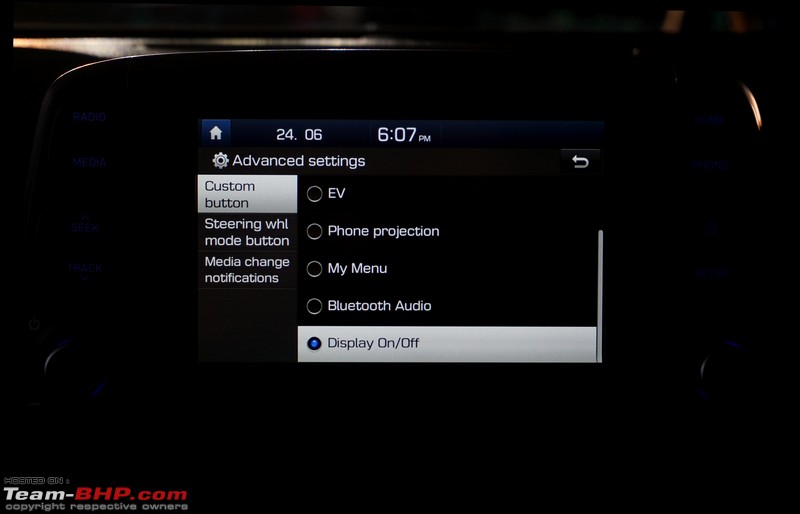 The steering wheel 'mode' button used to switch between various music sources can be set to toggle only between the sources you choose. No more AM white-noise blaring loudly as you switch:  Media information notification (eg. each time a new song plays) can be turned off here:  The keyboard type can be chosen, as well as the date & time format (on another screen):  You can arrange apps in your preferred sequence on the homescreen menu, or remove them with a drag-and-drop action:  The electric vehicle screen shows data on energy information, charge management and ECO driving:  The ECO driving screen displays the amount of carbon dioxide reduced when compared to a gasoline car:  It also gives the driving history with the average 'battery economy' (kWh/100 km):  The energy consumption screen gives you a useful breakup of what is utilizing your battery charge:  The climate control mode can be changed to increase range:  Voice memos can be recorded using the microphone installed in the vehicle and played back on the system:  The touchscreen doubles up as a display for the reversing camera. Resolution is fair and you get dynamic grid lines:  We've included additional details & screenshots of more specific charging controls available on the display, in the ‘Battery & Charging’ post below. Last edited by Aditya : 15th October 2019 at 10:10. |
| |  (24)
Thanks (24)
Thanks
 |
| The following 24 BHPians Thank ChiragM for this useful post: | 2himanshu, ADI7YAK, aeroamit, autonarr, Chrome6Boy, CrAzY dRiVeR, Gannu_1, GTO, hemanth.anand, jailbird_fynix, Keynote, Klub Class, Moto$apien, MSAneesh, phoenixash, RavenAvi, Rehaan, Reinhard, Simat, SS-Traveller, sukiwa, swiftnfurious, The_Outsider!, Varun_HexaGuy |
| | #7 |
| Senior - BHPian Join Date: Apr 2018 Location: Bangalore
Posts: 1,546
Thanked: 17,346 Times
| Battery, Range & Charging Battery Specs of the battery provided on the Kona in India: • 39.2 kWh capacityFor the sake of comparison, previously sold EVs in India had the following battery capacities: e2o (11 & 15.2 kWh), e-Verito (13.91 - 21.2 kWh) & Tigor EV (16.2 - 21.5 kWh). The long-term health of your battery has an effect on the available range as well as your wallet. We've shared some tips on maximizing battery life in the 'Charging' section below. Range As electric vehicles become more and more popular, manufacturers are soon going to be advertising their prowess in "km" figures, rather than "km/l". The ARAI-approved range for the 39.2 kWh Kona is 452 km. Being the official figure, this is the range that is being touted in all marketing material, as well as most reviews. However, let’s be clear that this is very far from the realistic range you can expect the Kona to return. For the ARAI test, the car is run at a constant speed of 40-45 km/h on a flat road and there is no wind resistance. Unrealistic. In real-world conditions, international reviews as well as a few Indian owners have reported figures ranging between 250-350 km. In our road-test, we managed to get: • 288 km on a city + highway trip (223 km traveled + 54 km range remaining + 10 km calculated adjustment for starting at 98%).Consistently getting above 250 km of range is excellent for an EV in today's times. Simply put, if you’re using the Kona as a purely city car, range should not be a concern whatsoever. However, if you regularly approach 250 km/day, managing range will require some planning. Charging The Kona can be charged with 3 different chargers: 1) Fastest: DC Quick Charger (50 kW): This is a CCS Type 2 charger that can charge the car from 0-80% in a blazing fast 57 minutes. It’s big, and it’s expensive – so isn’t ideal for personal ownership. Hyundai has tied up with IOCL (Indian Oil Corporation Limited) to set up these fast charging stations in 1 fuel pump in Delhi, Mumbai, Bengaluru and Chennai each. Hopefully, a good market response to the Kona will have more of these charging stations sprouting up soon.Additionally, in case you run out of charge on the road, Hyundai has a fleet of Konas equipped with a car-to-car power converter for charging. They are currently in four cities - Delhi, Mumbai, Bengaluru and Chennai. Hyundai has also tied up with MapMyIndia to display EV charging stations in their app, as well as on the Hyundai website. If you want to prolong the life of your battery, you need to understand that batteries hate HEAT. Charging results in high battery temperatures. The faster you charge a battery, the more heat gets generated. Hence, we'd suggest you avoid fast charging when not necessary, and even reduce the charging rate for daily charging via your vehicle's settings menu. In addition to that, you can set the Kona to stop charging at 80-90%, which also aids battery health. Doing these things will not only extend the lifetime of your battery, but will also minimize range-degradation as your battery ages. The lithium-ion polymer battery is placed at floor level:  A look at the battery pack. Watch out for those nasty speed breakers:  The charging port is at the front of the car. Dust caps have been provided:  A look at the charging port:  The portable 2.8 kW charger is placed in a bag in the boot. We measured it to be 5 meters in length:  The portable charger makes you feel like the Kona is a really big laptop:  It comes with an in-cable control box that displays various indicators for plug, power, charge, fault, charge level and vehicle status:  The 7.2 kW AC wall charger:  The charging screen gives the charging current, voltage, power consumption, and time:  The 7.2 kW chargers spotted at Hyundai dealerships look a bit different. Thanks to BHPian Sebring for this picture:  A look at the Kona connected to the charger. The green light surrounding the charging port indicates that the car is charging:  The MID displays the time remaining to full charge, as well as the charging current (2.4 kW in this case):  The DC fast charger that will be installed at a few IOCL petrol pumps:  While there are many charging socket standards, the most common ones are the CCS Type 2 and the CHAdeMO. The Kona comes with the CCS Type 2 charger. The charger combines AC charging as well as DC charging. The two lower contact pins are for DC fast charging. Most manufacturers including Jaguar, Volkswagen, BMW and Ford use CCS chargers, whereas cars like the Nissan Leaf use CHAdeMO charger. All public charging stations in India are expected to support both CCS, as well as CHAdeMO:  The charger screen displays various information. SOC stands for State Of Charge:  The light around the charging port gives the status of the charging. White indicates that the charging door is open and charging is on standby, green shows that the car is charging, blinking green indicates that scheduled charging is set, blinking red indicates a charging error, while a yellow light indicates that the 12V battery is charging or that the scheduled climate control is operating:  The battery indicator shows the battery level. The button to the right of it lights up when a scheduled charge is active. Pressing the button for 3 seconds cancels the scheduled charge in case of any emergencies:  On the infotainment display inside the car, the energy information screen shows the time required to charge from your current battery level up till 100% for each type of charger. Useful!:  You can set the limit to which you want the battery to charge. This is useful when you are charging from a station where you need to pay per unit of electricity used, or if you’d like to stop the charging before the charge rate slows down for the final few percent. This limit can be set separately for AC & DC charging:  You can also schedule off-peak charging to control the exact times between which the battery charges. This is useful when electricity pricing is different depending on the time of day. Scheduled climate will use the power from the charger to reach the desired cabin temperature set, without depleting the battery:  The off-peak charging time settings. You can choose to charge only during off-peak times, or prioritize off-peak charging:  Departure days & times can be set. Charging will be completed by the set departure time if the vehicle is plugged in long enough:  The charging current to be utilized from the AC chargers can be set. Useful if you’re concerned about the power drawn being too high for the wiring set-up where you’re plugging in, or if you want to maximize battery health by charging at a lower current:  Minimum, maximum or reduced current can be chosen individually for the station & portable AC chargers:  Last edited by Rehaan : 16th October 2019 at 10:49. Reason: Fixing CCS Type 2 link |
| |  (32)
Thanks (32)
Thanks
 |
| The following 32 BHPians Thank ChiragM for this useful post: | 2himanshu, aeroamit, akshay81, Alfresco, autonarr, Chrome6Boy, CrAzY dRiVeR, Dani7766, Gannu_1, gauravanekar, GTO, jailbird_fynix, Klub Class, ksbhat, Moto$apien, MSAneesh, Omkar, phoenixash, Punatic, RaghuVis, RavenAvi, Rehaan, samabhi, shipnil, Simat, sri_tesla, sukiwa, swiftnfurious, theexperthand, The_Outsider!, vb-saan, wheelguy |
| | #8 |
| Senior - BHPian Join Date: Apr 2018 Location: Bangalore
Posts: 1,546
Thanked: 17,346 Times
| Driving the Kona Electric Acceleration & Power The 39.2 kWh Kona comes with a 100 kW motor. That equates to 134 BHP of power, and torque is rated at 395 Nm. The advertised 0-100 km/h time is 9.7 seconds. To put that into perspective, it matches the Polo GT TSI. It’s snappy! When Hyundai informed us that the electric car drive was at the Buddh formula 1 circuit, I thought it was a pretty bad idea. But as soon as we were out of the pits and turned the first two corners I changed my mind! This thing is fun. Hitting the second corner, powering through it, a bit of wheelspin and a touch of opposite lock; it is a surprisingly fun and well-composed car! Interestingly, the Kona felt very much at home on the track. Unlike an internal combustion car, where the engine would be screaming and running out of breath towards the end of each gear, the Kona did it without any theatricals. Just the squealing tyres. We even gave it a bit of a high-speed run down the straight and it pulled northwards of 150 km/h without making us wait too long. As much fun as it might be on track, it’s on the streets that the beauty of max torque from 0 RPM really shines. What I absolutely love about an electric car in city traffic is that there is just nothing that can beat it off the line so effortlessly. Quietly, no revving up, no slipping clutch, no going high up the revs. Just a faint electric purr and you are out ahead of everyone else at the signal. If there is anyone keeping up, they are probably giving it the beans and the whole world can tell. At most, the Kona lets out an electric whirr that’s noticeable if you listen closely enough. You could even say that the electric whine is kind of space age and cool. Closing gaps in traffic and doing quick overtakes is also seamless, thanks to the punchy nature at city speeds. In a conventional-engined car, you have to think about which gear you are in, what speed you are at and whether you need to downshift. In an electric car, the ever-present & linear torque delivery makes it so seamless. The lack of gear changes also enables a smoother experience for passengers. Driving Modes The Kona has 4 selectable driving modes. Each mode has a differently mapped throttle response, brake regen level defaults, instrument cluster display layouts, and a few ancillary changes to optimize battery utilization. You can cycle through these modes by pressing the ‘Drive Mode’ button located ahead of the front edge of the driver’s armrest. I didn’t like where this drive mode button was placed because you have to take your eyes off the road to locate it, and then crane your elbow back to manage to reach it with your fingers. The 4 drive modes available are: • Sport Mode: Needless to say, the throttle is the sharpest and most eager in this mode. The car feels peppy, with even a 25% dab of the throttle having the nose rise up as the car surges forward. That said, it’s still easily usable in everyday driving. The main dial on the instrument cluster has the needle pointing to the ‘power %’ being utilized with a digital speed reading in the middle. I’m not so much of a fan of this – simply because I know how far down my foot is on the throttle, and I’d rather see the needle showing the speed. In Sport mode, the brake pedal also gets an extremely wooden feel to it for the first inch or two of travel, after which it regains some feel and gets a bit easier to modulate.PRND Selection The Kona has a single-speed reduction transmission. You do however have to switch between Park, Neutral, Reverse and Drive using a set of 4 buttons. This isn’t too difficult to get used to. However, the issue is locating and using the buttons quickly without having to look at them for reference every time. The Park button does have a textured strip at the top of it, but even then, it’s still hard to confidently locate the others in a purely tactile way. We grumbled about this quite a bit, but then discovered a way to make it work. There is a raised mound behind this set of 4 buttons. If you cup that with your left palm, the buttons fall consistently at your fingertips, making them much easier to use without having to look at them. Quick-shifters take note that your foot has to be on the brake pedal when switching between PRND. This can sometimes catch you off-guard when doing a really quick 3-point turn, and the transmission hasn’t actually shifted between Reverse and Drive despite you pressing the button. It doesn’t matter if the Kona is at 0 km/h – you have to have your foot on the brake to make a successful shift. Parking Brake The Parking Brake (P) is an electronic pull / push switch located a few inches behind the PRND selector buttons. It engages and disengages the rear brakes with a soft electric whirring sound. It’s important to know that the Parking Brake is more of a ‘prevent the car from rolling or auto-creeping forward’ than a safeguard against accidental acceleration. As soon as you press the accelerator, the Parking Brake will disengage! This is unlike the conventional handbrake behaviour, and can be a little dangerous – especially in a car that makes no engine noise to warn the person in the driver’s seat that it is running. The Parking Brake will also disengage as soon as you switch between modes on the transmission selector (eg. go from Reverse to Drive). Conversely, there are times when the Parking Brake automatically engages. For example, if you open the door whilst the car is in Drive – the brake will engage. This is a good safety feature to prevent the car from rolling. Do note that since the Parking Brake is electrically actuated, it takes about 1.5 seconds to fully engage. As a result, if you leave the brake pedal as soon as you pull the Parking Brake button, the car will surge forward slightly before the brakes fully bite. In other words, you need to keep your foot on the brake pedal for at least a second or two after pulling the Parking Brake. When the transmission is in “Park” but the Parking Brake isn’t engaged, the car can roll up to an inch or two forwards and backwards (eg. if someone leans on it). Remember to always park safe & use the Parking Brake. Auto-Hold By default, the Kona starts to move forward as soon as you take your foot off the brake pedal. This is the safer default mode for a dead-silent EV, since it doesn’t give the person in the driver’s seat the opportunity to presume the vehicle is ‘parked’ and do some damage by accidentally hitting the accelerator. Conversely, the fact that it moves forward once you release the brake could catch people unaware too - but the behaviour is more like a conventional automatic that people are used to. The alternative is turning on ‘Auto Hold’. With this activated, the Kona will hold itself in place every time it comes to a complete stop. Touching the accelerator will release the Auto Hold. This mode is much more convenient in stop & go traffic, as you do not need to keep your foot on the brake, and aren’t really required to keep playing with the Parking Brake or transmission selector. For the sake of safety, Auto Hold always resets to ‘off’ every time the car starts up. Brakes Similar to fossil-fuel vehicles, Electric Vehicles can brake in two ways; using the brake discs & via engine braking. However, the difference here is that when an EV brakes with engine braking, the motor is actually working as a generator and recharging the battery using the vehicle’s momentum. As a result, all modern EVs have regenerative braking built-in. However, brake regen adds a degree of complication to the braking procedure. The braking system has to intelligently figure out when it should be using the ‘engine braking’ and when it should be using the brake discs – most EVs do a damn good job of this. They also have to mix and smoothly transition between the two types of braking, which have their own unique deceleration characteristics and feel; and quite frankly no EV does a perfect job of it. This results in two things - brake pedal feel being artificial and braking results being non-linear. The Kona is no exception. The non-linear braking behaviour makes it a little hard to modulate smoothly, especially for the first 10% of brake pedal travel – where only the regen braking is kicking in before the calipers actually grab the discs. In addition to that, in Sport mode the brake pedal becomes extremely wooden. We’re not sure why this happens, but it wasn’t an issue in Eco or Comfort modes. Mind you, regardless of brake pedal feel, braking performance is excellent. The car is smart enough to always apply ‘engine braking’ when required, so that greatly aids the stopping power. Even on the racetrack, we didn’t ever have the ABS intruding on hard braking. Regenerative Braking Another great trick the Kona has up its sleeve is the ability to fine-tune how much brake regen gets applied. The amount of battery recharge coming from these modes finally totals up to roughly the same thing, but what’s different is the level of aggressiveness or immediacy of the regenerative brake force applied. You’ll feel the regen kick in as soon as you begin to release the accelerator pedal. You can adjust the level of regen by using the ‘paddle shifters’ behind the steering wheel. Pressing the left paddle increases the aggressiveness of the regen (think of it like downshifting), whilst pressing the right paddle eases up on the regen. There are 5 different levels of regenerative braking that you can choose between: • Level 0: This effectively turns off the brake regen. When you lift your foot off the accelerator, there is absolutely no brake regen or engine braking applied. The Kona will continue to coast forward as if it were in neutral. Needless to say, no recharge happens when you lift off the accelerator pedal on Level 0.Steering Whether driving on the track, on the highway or in the city, we had absolutely no complaints about the Kona’s steering. This is usually a weak point for Hyundais, but they’ve done a good job here. Let’s be clear that it’s far from an involving enthusiast steering, and it lacked feedback. But it’s direct, weighs up nicely (a touch on the heavy side, even at city speeds) and it’s got good on-centre feel. The average driver won’t have any complaints at all. Handling Handling too is impressive for a car that is a crossover / SUV. Body roll is certainly present, but it is very well managed. The suspension is clearly sprung a little stiff, and having the weight of the battery at floorboard level helps keep the center of gravity low. Watching people clipping their test drive Konas through the chicane at BIC at 80-90 km/h, we could see the car roll a bit, but then hold itself there quite maturely. The weakest link in the handling equation is the Nexen N'Fera SU1s. Despite being marketed as high-performance summer tyres, they left us wanting more. Even when driving through the Lonavala ghats, GTO said that he could feel the tyres losing grip way before the car wanted to, accompanied by the smell of burning rubber. Ride Quality I’ll be frank. The worst thing about the Kona is the ride quality. By a long shot. The ride is taut and uncompromising. Think EcoSport, but worse. It’s uncomfortable on imperfect roads. Potholes, especially the big ones, come in bone-jarringly sharp. What’s more, Rehaan says that even mild undulations on well-paved tarmac roads (eg. lightly wavering Marine Drive) had him being shaken up and down. If you were travelling along this same road in any other car, you wouldn’t have even noticed this unless you were really paying attention. Even minor undulations on flyovers and on the expressway can be felt in the car. This is not a plush ride at all. Interestingly, we would have never figured this out during the media drive on the track. We got a tiny hint of it as we crossed an expansion joint in the garage lane, but this is something that only the real-world experience of driving on the road let us figure out. The Kona has a surprisingly high recommended tyre pressure of 36 PSI. Could this be because of the weight of the car? Is it a way to improve battery range? We’re not sure. But we did reduce the pressure to 32 PSI to see if it improved the ride – and the answer is; not much. Perhaps the stiff sidewalls of the Nexens are a contributing factor too. Combine the poor ride quality with the un-ergonomic seating position of the rear bench, and you'll quickly realise that the Kona is far from ideal for rear seat passengers. Ground Clearance The Kona certainly doesn’t have the ground clearance of an SUV, or even a crossovers. Hyundai did not share any official ground clearance figure with the press, despite many requests for it. There's no doubt that it's an unimpressive figure, especially for an "SUV". On extremely broken rural roads the Kona scraped where regular sedans would scrape (eg. Honda City). Even dressed-up hatchback crossovers would not scrape in these places. We faced no issues on urban speed breakers though. We measured the ground clearance of the Kona to be ~171 mm, however, this is a constant low-point (battery housing) across the entire wheelbase of the car, making it much more likely to bottom out. NVH / VESS Despite the silence of an electric car making other sounds more noticeable, road noise was well controlled, and wind noise is barely present below 100 km/h. The silence of electric cars has made certain governments put requirements in place to have EVs make an audible sound when in motion, in order to warn pedestrians, cyclists, etc. I even found myself using the horn more often than I would have if I was driving a regular noisy car. The Kona has a Virtual Engine Sound System (VESS) to create somewhat of an audible warning, but more so to fulfil this legislative requirement. It turns itself on every time you start the car, but can be disabled by pressing the VESS button near the driver’s right knee. Even with the system enabled, we could barely hear the difference (inside and outside the car). There was just a slight electric hiss / whine when the VESS was turned on, and surprisingly it was equally audible inside the cabin as it was outside of it. When VESS is enabled, a beeping sound plays when you put the car in Reverse gear – did you ever think reversing horns would come back in vogue? The VESS sound was just about audible at the track, but may not be heard on our noisy streets. The system was manually switched on at the 00:16 mark in the video during a slow drive-by. You can also listen to the sound difference between the Tuscon (lead car) and the Konas down the main straight: The engine bay layout is rather conventional. Remember, the Kona is also sold with gas-guzzling engines internationally:  Pull off the plastic cladding, and this is what you're left with. There is a LOT of free space in this engine bay:  You get a regular 12V battery too. It charges off the main battery pack periodically:  If you look deeper you can see the bell housing of the single-speed transmission:  Interestingly, the underside of the hood gets sound insulation:  The firewall gets insulation too:  The MID displays instructions on using the transmission selector, as well as displays which gear you select: 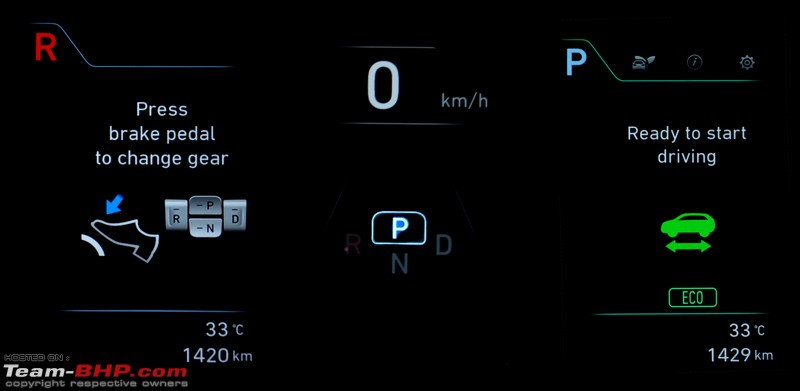 When you cup the strange bump with your hand, the PRND buttons fall at your fingertips, making them easier to operate without taking your eyes off the road: 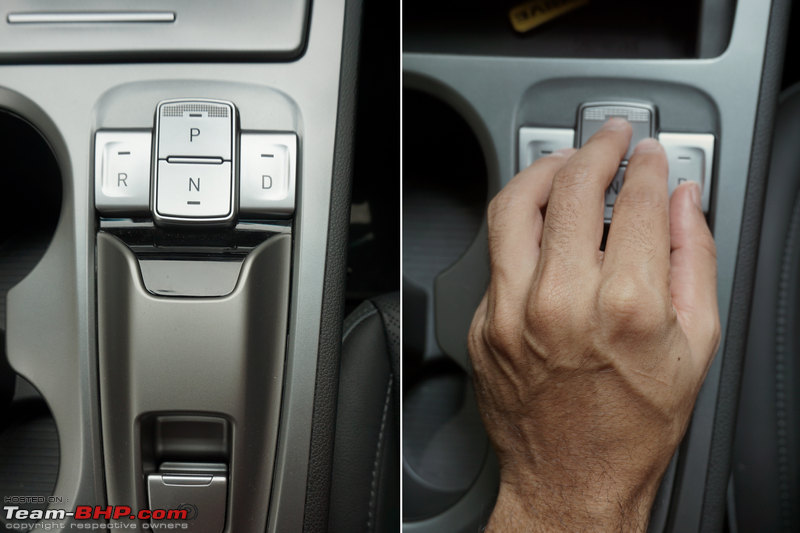 When you switch the Drive Mode, the MID indicates what mode you've chosen:  The infotainment screen also displays a full-screen notification:  The Sport mode instrument cluster layout shows a "Power %" dial. Note the remaining km in the top right for this mode and the following ones:  Comfort mode's display is more traditional. The range displayed dead-center is convenient:  For Eco mode the dial goes green, indicating the zone you should stay in. Note the increase in range (top right):  Eco+ is the same as Eco, with an unchangeable 90 km/h limit. You'll also be sweating it out without any climate control, but note the range bump:  The additional km of range gained from regenerative braking is displayed in the Eco / Eco+ modes. This add-on counter resets each time you brake. Note the blue icon for the regen level (0-3) displayed below:  The default regen level can be set for each drive mode. Every time you switch drive modes, the regen will always reset to this pre-defined level:  The settings for each drive mode can be changed individually:  Climate control and energy regeneration can be adjusted for the ‘Comfort’ and ‘Sport’ driving modes:  For Eco mode, the maximum speed limit can also be set. Eco+ is fixed at 90 km/h:  The alert notification for a change in Drive mode can be selected too. You can disable the big pop-up on the infotainment screen:  Last edited by Aditya : 15th October 2019 at 10:15. |
| |  (31)
Thanks (31)
Thanks
 |
| The following 31 BHPians Thank ChiragM for this useful post: | 2himanshu, ach1lles, aeroamit, anandpadhye, arvind71181, autonarr, Chrome6Boy, CrAzY dRiVeR, Dani7766, Enobarbus, Gannu_1, GTO, haisaikat, hemanth.anand, jailbird_fynix, Keynote, Klub Class, Moto$apien, MSAneesh, RaghuVis, RavenAvi, Rehaan, Reinhard, Simat, SS-Traveller, sukiwa, swiftnfurious, theexperthand, The_Outsider!, Varun_HexaGuy, vb-saan |
| | #9 |
| Senior - BHPian Join Date: Apr 2018 Location: Bangalore
Posts: 1,546
Thanked: 17,346 Times
| Other Points • The electric version of the Kona was unveiled at the 2018 Geneva Motor Show and is sold in Australia, Canada, Europe, Korea, United Kingdom, and the United States. • In the international market, the Kona is also offered in conventional petrol, diesel and hybrid variants. They get slightly different exterior and interior design. • The Kona is named after the western district of Hawaii. The car is also called Kauai in Portugal and Encino in China. • Hyundai showcased the non-electric Kona Iron Man Edition at the 2018 Auto Expo. • The electric Kona was first seen testing in India in October 2018. • The electric Kona was showcased at Move: The Global Mobility Summit 2018 held in New Delhi in September 2018. • The Kona Electric is brought in as ‘Part-by-Part’ (PxP), which we're told is very similar to CKD. It is assembled at Hyundai's plant in Chennai. • Here's a controversial thought: Just like drivers of certain luxury brands or registration districts sometimes have a bad reputation, I wonder if the opposite will become true for cars with green number plates. Obviously the owners care enough about the planet to put their money where their mouth is, so maybe they will also be more responsible road users, exhibit better road manners and more civic sense? • When filing air at the pump, even the attendants there keep agreeing that this is the future, ironically “because diesel and petrol are becoming so expensive”. Everyone is impressed with the 280 km range. • Based on current electricity rates, the running cost of the Kona works out to a paltry 0.8 - 1.1 Rupees / km. GTO did Mumbai – Pawna – Mumbai in just 220 bucks. The cost is so insignificant that it'll be a rounding off error for most households. In fact, he paid more in tolls than he did for the electric charge. • I love that you can set the soft-touch turn indicator to either be off, 3 flashes, 5 flashes, or 7 flashes. The default 3 flashes in most cars is just too short. • Hill-hold prevents the Kona from rolling backwards on inclines. Another advantage of EVs - there’s no clutch slipping wear & tear during hill starts. People who have to park on a slope regularly will appreciate this. • Sometimes despite your foot being on the accelerator, you feel a difference in the Kona's resistance to moving forward when you change the regen braking level. This happens because even when your foot is pressing the accelerator, the car may just be coasting (not actively accelerating), and hence a change in the aggressiveness of the regen can be felt. • Regenerative braking does not work when in reverse gear. Also, you cannot change the current level of regen whilst your foot is on the brake pedal. • The official kerb weight has not been shared by Hyundai. Unofficial figures point to a hefty 1,535 kg for the 39.2 kWh version. Undoubtedly, the batteries make up a large part of the weight. • Service interval is every 10,000 km. Part of the air-conditioning system also helps cool the battery, and the coolant for this is changed at each service. • Standard warranty coverage is for 3 years / unlimited km. Extensions for the 4th and 5th years / 1,00,000 km can be purchased. We strongly recommend the max possible coverage available. • Hyundai is providing roadside assistance to all new Konas for a period of 3 years from the date of sale. • Warranty coverage for the battery is 8 years / 1,60,000 km. The main concern with older EVs was that the battery would have to be replaced within a few years, increasing the ownership cost significantly. An 8-year warranty will bring peace of mind to the owners. • Service bays for the Kona get electrically insulated floor mats. Service personnel get insulated gloves and tools. • In July 2019, the government reduced the GST on electric cars from 12% to 5% and the price of the Kona reduced by Rs. 1.58 lakh. The government will also provide an additional income tax deduction of Rs. 1.5 lakh on interest paid on loans taken for the purchase of electric vehicles. • BHPian PPS brings to our notice that some states like Maharashtra, Karnataka, Rajasthan & Goa don't levy any road tax while registering EVs. • Hyundai says they have received 300 bookings so far, and as a result, all allocated units for India in 2019 have been sold out. • A Hyundai Kona EV in Canada caught fire in a garage recently. The cause hasn’t been conclusively determined as yet. • When setting up your charging station at home, do also account for the additional cost of wiring required from the meter box to your parking spot. BHPian sheldon.dz says that he paid Rs. 28,000 for the wiring that was installed by his building maintenance team. • Hyundai is expected to build a dedicated EV platform called E-GMP, which will have flexible battery capacity and a high voltage system to reduce charging time. • View the Hyundai Kona Electric brochure (Kona_Brochure.pdf), and the owners manual (Kona_Owners_Manual.pdf). • Disclaimer: Hyundai invited Team-BHP for the Kona Electric test-drive. They covered all the travel expenses for this driving event. Last edited by Aditya : 16th October 2019 at 20:32. |
| |  (37)
Thanks (37)
Thanks
 |
| The following 37 BHPians Thank ChiragM for this useful post: | 2himanshu, ach1lles, ADI7YAK, aeroamit, anandpadhye, autonarr, Chrome6Boy, CrAzY dRiVeR, Dani7766, DrCar, Gannu_1, GTO, haisaikat, Hayek, hemanth.anand, jailbird_fynix, Keynote, Klub Class, Moto$apien, MSAneesh, Omkar, Punatic, RaghuVis, RavenAvi, Rehaan, Reinhard, samabhi, sharktale, shipnil, Simat, SS-Traveller, SS4, sukiwa, swiftnfurious, theexperthand, The_Outsider!, vb-saan |
| | #10 |
| Senior - BHPian Join Date: Apr 2018 Location: Bangalore
Posts: 1,546
Thanked: 17,346 Times
| The Smaller yet Significant Things The Kona Electric is available in Marina Blue...  ...Phantom Black...  ...Typhoon Silver...  ...Polar White...  ...and Polar White with a Phantom Black roof. The dual-tone variant costs Rs. 18,750 more:  The Kona media drive was held at the Buddh International Circuit. Note the heavy-duty electric wiring that had to be retrofit to charge the cars in the pits:  The eye-catching green plates, closed off grille, and small 'electric' badge at the rear did a good job of announcing it was different. Tons of people showed interest in the car, and were aware it was electric:  Remember the strange protrusion on the headlights? Could they be designed as a safe space to accumulate condensation within the headlamps? Both headlamps looked like this one evening. Note the striped channels leading to the protrusion as well:  The key gets piano black and silver accents. It can be used to lock / unlock the car and open the boot:  The Kona Electric comes with a ‘Utility mode’. This mode activates all the features of the car, except the drivetrain, preventing unnecessary battery drain. It lets you use the USB chargers, AC, and the music system:  The AC can be switched on for the driver only. It optimizes power use when there's only the driver in the vehicle:  Running just the air conditioner uses about 0.45-0.56 kW of power. That means you can run just the AC for close to 3 days before the battery runs dry:  A phone being wirelessly charged on the in-built Qi charging pad:  The Kona has one of the best dual-tone horns we've heard. It’s smooth and full bodied. Superb choice of sound. However, when locking / unlocking the car, the honk that sounds is really high pitched and irritating – which comes from the alarm system horn shown here:  It's one of the rare cars where the laden and unladen tyre pressure is the same - a relatively high 36 PSI front and rear. Interestingly, they start off at a rather high baseline of 3 people + some luggage in the car, and go up to 5 people + more luggage:  Full cladding in the front wheel well...  ...and partial cladding in the rear:  The Kona doesn't have an officially mentioned ground clearance figure as yet. We had to do it ourselves  . 171 mm was the reading we got at the lowest point in the middle of the wheelbase. For comparison, an i10 Grand was 198 mm at the same point: . 171 mm was the reading we got at the lowest point in the middle of the wheelbase. For comparison, an i10 Grand was 198 mm at the same point: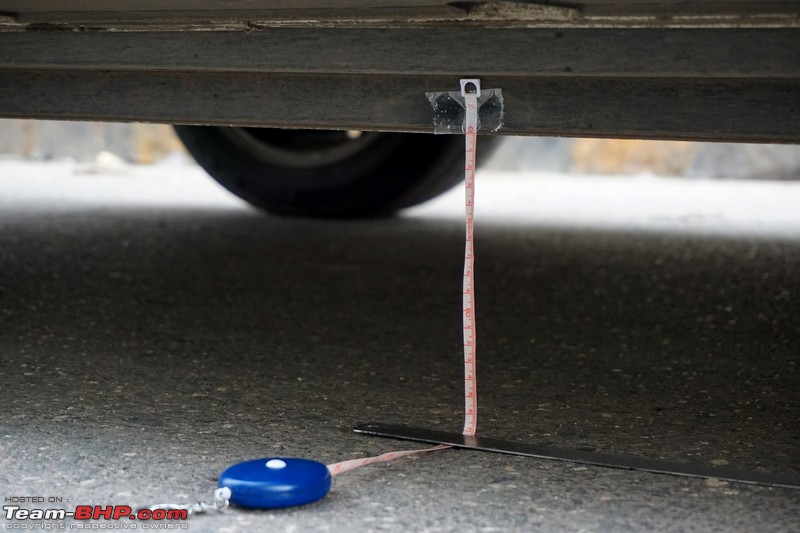 The lowest point at the front were the aero flaps in front of the wheels. 133 mm was the measurement here:  Last edited by Aditya : 15th October 2019 at 10:20. |
| |  (55)
Thanks (55)
Thanks
 |
| The following 55 BHPians Thank ChiragM for this useful post: | 2himanshu, ach1lles, Aditya_Bhp, aeroamit, AGwagon, akshay81, Alfresco, anu007, Arwin07, asingh1977, autonarr, AYP, BoneCollector, Carbon-Steel, Chrome6Boy, CrAzY dRiVeR, Dani7766, docprashant, espraveen, Gannu_1, GTO, haisaikat, Hayek, jailbird_fynix, Keynote, Klub Class, lazybird, mallumowgli, Moto$apien, MSAneesh, myavu, Omkar, PISTONS, puneetakhouri, RaghuVis, RavenAvi, Rehaan, Reinhard, Rocky_Balboa, samabhi, Sheel, Simat, sri_tesla, SS-Traveller, SS4, sukiwa, swiftnfurious, Tgo, The Rationalist, theexperthand, The_Outsider!, TSIboy, vb-saan, vgsr, Vik0728 |
| | #11 |
| Team-BHP Support  | Re: Hyundai Kona : Official Review Thread moved from the Assembly Line to Official Reviews. Thanks for sharing! |
| |  (6)
Thanks (6)
Thanks
 |
| The following 6 BHPians Thank Aditya for this useful post: | ChiragM, GTO, hemanth.anand, Rehaan, sri_tesla, uday.ere |
| |
| | #12 |
| Senior - BHPian Join Date: Apr 2011 Location: Dubai/Bengaluru
Posts: 3,590
Thanked: 11,093 Times
| Re: Hyundai Kona : Official Review Wow! Superb review of a truly 'electric' car. This is the car that showed me how feasible electric mode of transport will be, in our Country (especially with range concerns), and welcome the future! Rating it 5 Stars! |
| |  (3)
Thanks (3)
Thanks
 |
| The following 3 BHPians Thank Sebring for this useful post: | GTO, PapaKiloSierra9, sri_tesla |
| | #13 | |
| Team-BHP Support  | Re: Hyundai Kona : Official Review Quote:
 I was really surprised by this comment on the ride quality, as it never came up from anywhere else - and no wonder - because the media drives were all conducted on the perfect track at BIC. An excellent first effort from Hyundai. However, I do feel that MG might get the last laugh in this competition! Good to finally see some mainstream electric vehicles getting launched in India. | |
| |  (5)
Thanks (5)
Thanks
 |
| The following 5 BHPians Thank CrAzY dRiVeR for this useful post: | AGwagon, Alfresco, GTO, haisaikat, RavenAvi |
| | #14 |
| Senior - BHPian Join Date: May 2012 Location: BLR/PTR
Posts: 3,281
Thanked: 9,660 Times
| Re: Hyundai Kona : Official Review Finally the review is here  . Kona to me has great potential to be best urban commuter. But at 23-24lacs this is . Kona to me has great potential to be best urban commuter. But at 23-24lacs this is  Launching electric cars now is little too early in India, given the cost, lack of infrastructure and unknown reliability/resale. Launching electric cars now is little too early in India, given the cost, lack of infrastructure and unknown reliability/resale.That said biggest surprise to me is the interiors. Is it the photo? the interiors screams CHEAP! Definitely not befitting a 23Lac rupee car. Kona has comprehensive list of features which is good. |
| |  (2)
Thanks (2)
Thanks
 |
| The following 2 BHPians Thank PrideRed for this useful post: | GTO, Shashwat.75 |
| | #15 | |
| Team-BHP Support  | Re: Hyundai Kona : Official Review Quote:
 . . Anyone interested in electric cars must read my thread on the topic. Last edited by GTO : 15th October 2019 at 11:00. | |
| |  (16)
Thanks (16)
Thanks
 |
| The following 16 BHPians Thank GTO for this useful post: | ADI7YAK, ashis89, autonarr, CrAzY dRiVeR, espraveen, hkollar, jailbird_fynix, RavenAvi, Reinhard, Sebring, sri_tesla, SS-Traveller, The Rationalist, The_Outsider!, vb-saan, wheelguy |
 |



